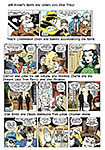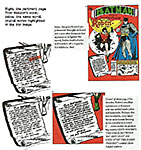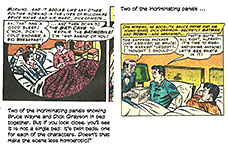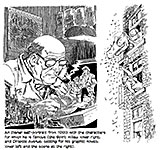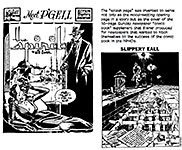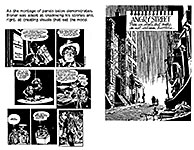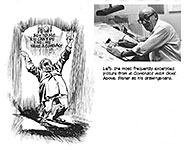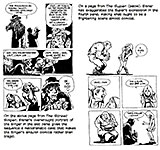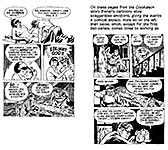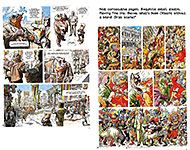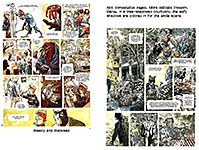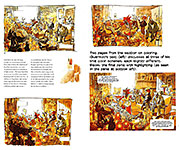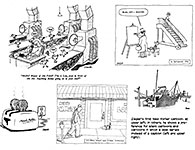 |
||||||||||||||||||||||||||||||||
Opus 365 (May 6, 2017). We planned to get this installment posted a week ago. And it was, at that time, a short and sweet opus. But Fate conspired against us. Just as we were wrapping up the tidy package, fresh news broke, and we, ever conscientious and dutiful, scrambled to record it. This always happens to us: late-breaking news suddenly surfaces, and our best laid plans gang aft agley, as Robbie Burns would say. The Trumpet kept doing new idiotic things, so we altered and added to what we’d already written. Then Bob Mankoff announced, just the day after leaving The New Yorker, that he was becoming humor and cartoon editor at Esquire. Added that. Then a day after that addition, more information about his move arose. Added that. Then we found what Playboy had to say about Jack Ziegler. Added that. Then more information about cartooning in distant countries with repressive regimes popped up. Added that. Syrian cartoonists are still at it. Added that. Every time something new happened, we had to add a little moron. To wit— Hare raising news of the month about the Marvel artist who snuck politics into a comic book; Bob Mankoff, former cartoon editor at The New Yorker, going to Esquire the day after he moves out of his office; new cartoon format at The New Yorker?; the Denver Independent Comics and Art Expo; several reports on repression of cartoonists abroad and (even) here, women cartoonists cracking the ceiling, classic look revived at Archie, how Staton and Curtis got the Dick Tracy gig, plus reviews of a new analytic book about Batman, an expanded biography of Will Eisner, and graphic novels Eisner’s A Contract with God (revisited) and Blacksad. And notes about comic books Snotgirl, Tank Girl, I Hate Fairyland, All Star Section Eight, Grass Kings, and American Gods. Not to mention our continuing examination of the evils of Trumpery. We’ll post the complete list in a trice.
MEANWHILE, WE’VE SUCCESSFULLY NEGOTIATED another Easter, dying eggs and indulging a species of cannibalism by eating chocolate bunnies. We look forward every year to the arrival of this holiday, hoping that this year, we’ll see the Easter Bunny suitably attired in red short pants, white three-finger gloves, and giant yellow shoes. Our hope, of course, is in vain: the long-eared leporidae re-appears faithfully in fur and only fur from head to paws. Our church is surrendering to a weird brand of political religious correctness: they’ve started calling Easter by another name—Resurrection Sunday—because, I assume, Easter is a word with a pagan (or at least non-Christian) history that the Passionate Faithful wish to shed. Naturally,
I deem this effort as not only misguided but misbegotten. “Easter,” the word as
well as the holiday, has a history, and to consign the word to Limbo is to deny
history—which, in this case, seems to me like denying the religion And now, to enable you to pick just those articles you want to spend time on and skip the ones in this massive installment of Rancid Raves that are of little interest to you, here’s what’s here, in order, by department—:
NOUS R US Morin Gets Pulitzer Mankoff Lands at Esquire DINK Does Well Marvel Artist Does Politics in X-Men Marvel Diversity Turns Readers Off? Turkish Cartoonist Faces Jail Sentence Zunar Wins One Another Seditious Malaysia Cartoonist Syrian Cartoonists Continue the Fight
Censorship in U.S. Alive and Well Trumpest at the Border Stops Cartoonist New Cartoon Format at The New Yorker Humor Times Is 26 Classic Look Lives On at Archie Comics Sales Chartoon at Time
Odds & Addenda Lucky Luke is 70 Looney Tunes at DC Free Comic Book Day, May 6
FUNNYBOOK FAN FARE Reviews and Comments on—: Snotgirl Tank Girl I Hate Fairyland All Star Section Eight Grass Kings American Gods
WOMEN CARTOONISTS ASSAULT CEILING More and More
EDITOONERY Trumpery All Over The Evils Thereof Sampling the Best Editorial Cartoons of the Month
NEWSPAPER COMICS PAGE VIGIL Comic Strip Antics
THE SPIRIT JOINS TRACY TO FIGHT CRIME The Crossover and— How Staton and Curtis Got the Tracy Gig
BOOK MARQUEE Mad about Trump
BOOK REVIEWS Long Reviews Of—: Caped Crusader: Batman and the Rise of Nerd Culture Will Eisner: A Spirited Life, Deluxe Edition
LONG FORM PAGINATED CARTOON STRIPS Reviews of Graphic Novels—: A Contract with God and Other Tenement Stories: Centennial Edition Blacksad: A Silent Hell
PASSIN’ THROUGH Jack Ziegler
QUOTE OF THE MONTH If Not of A Lifetime “Goddamn it, you’ve got to be kind.”—Kurt Vonnegut
Our Motto: It takes all kinds. Live and let live. Wear glasses if you need ’em. But it’s hard to live by this axiom in the Age of Tea Baggers, so we’ve added another motto:. Seven days without comics makes one weak. (You can’t have too many mottos.)
And our customary reminder: don’t forget to activate the “Bathroom Button” by clicking on the “print friendly version” so you can print off a copy of just this installment for reading later, at your leisure while enthroned. Without further adieu, then, here we go—:
NOUS R US Some of All the News That Gives Us Fits
MORIN GETS THE OTHER HALF OF HIS SET OF BOOKENDS Two decades after Jim Morin won his first Pulitzer Prize for editorial cartooning, the Miami Herald veteran now has a matching bookend reports Michael Cavna at the Washington Post’s Comic Riffs. And he goes on—: Morin, who joined the Herald in 1978, was named the winner of the 2017 editorial cartooning Pulitzer on Monday, April 10, for a portfolio that “delivered sharp perspectives through flawless artistry, biting prose and crisp wit,” according to a five-person jury. Morin called the honor “very satisfying” — especially because, he told Cavna, “I’m always dissatisfied with what I do, and keep trying to change and explore to improve the drawings.” His
winning cartoons ranged from the 2016 presidential campaign to restroom
politics to the Flint, Mich., water crisis. Samples herewith. Morin, a Syracuse alum who was born in Washington, was a Pulitzer finalist in 1977 — the year before he joined the Herald — and again in 1990. He first won the Prize in 1996. “It’s amazing to be honored toward the end of your career,” he said. Morin’s trophy shelf includes the 2007 Herblock Prize, the 2000 Fischetti Award and the 1999 Thomas Nast Society Award. The 2017 finalists were past Pulitzer winner Steve Sack of the Star Tribune (Minneapolis) — who last month won the Overseas Press Club’s Thomas Nast Award — and past Herblock Prize recipient Jen Sorensen, who is a freelancer. The Pulitzer jury included two cartoonists — 2014 Pulitzer winner Kevin Siers of the Charlotte Observer and 2015 Pulitzer winner Adam Zyglis of the Buffalo News — in addition to three other journalists.
MANKOFF LANDS AT ESQUIRE Late-Breaking News, Kimo Sabe! One day after his last day at The New Yorker, Bob Mankoff accepted a job at Esquire—as cartoon editor, the position he filled at The New Yorker for almost 20 years. “Cartoon and humor editor,” as the position is styled, is a new one at the Hearst-owned men’s glossy. According to Hearst, reported Alexandra Steigrad at wwd.com, Mankoff will be responsible for “reviving the decades-long tradition of cartoons in Esquire,” which published more than 13,000 cartoons dating back to the 1930s. (For more about the founding of Esquire, visit Harv’s Hindsight about E. Simms Campbell in May 2013.) For years, Esquire’s full-page color cartoons rivaled The New Yorker’s expansive treatment of the medium and were the envy of cartoonists nation-wide even if they did not aspire to be published in the men’s magazine. “Mankott will edit humor stories, pitch ideas, draft cartoons and recruit a new generation of humorists to Esquire and Esquire.com,” said Steigrad. “He will also find ways for the magazine to make its original cartoons available for prints and licensing,” which is what he did when he created the Cartoon Bank that, later, The New Yorker bought from him (a condition of the sale being that Mankoff be named cartoon editor—see March 2017 Hindsight on Mankoff; dunno what he finagled at Esquire). “Bob is one of the funniest, most creative people I know,” said Esquire editor-in-chief Jay Fielden. “What he’s going to do is invent an entirely new look and sensibility in cartooning by upping the aesthetics and embracing a wide set of fresh voices. ‘La La Land’ proved an old form can become a new sensation. That’s the ambition here.” Mankoff, as we might expect, is eager to begin and, as a student of magazine cartooning, appreciative of the role Esquire played in the development of the single-panel magazine cartoon. “Esquire was home to some incredible cartoonists and humorists over the years, and it’s a real thrill to be able to reintroduce and reinterpret that legacy for a new audience,” Mankoff said. But he won’t be doing it by using the “open door” policy he followed at The New Yorker. “That selection process,” Mankoff told Michael Cavna at the Washington Post’s Comic Riffs, “is delusional.” The policy permitted cartoonists—even unknowns—to submit cartoons face-to-face with Mankoff, an encounter that often ended in swift rejection. Each line drawing effectively got only an instant audition, so even promising gags that didn’t quite “sing” right then and there were quickly rejected. Mankoff now believes there’s a better way to nurture good cartooning that just leaving the office door open to all comers. “It’s important to use these editorial muscles that I’ve developed over all these years,” said he. “I want to try something new,” Mankoff said. “I’ve had this idea for a long time, but in the New Yorker context, it didn’t make sense.” Probably because at The New Yorker, he was working with a significant number of long-time contributors, all experienced enough to turn up their noses at the scheme he’s now contemplating. He imagines his new approach could “reinvigorate the ecosystem of magazine cartoons.” His new idea: what if he were to work closely with a handful of different cartoonists every issue, in a process that he says would “feel less hierarchical” and “more productive”? His goal is to spotlight each humorist’s voice by helping them to develop their material. Mankoff wouldn’t work just with artists, but also performers. “I want stand-up comedians to work with cartoonists, too, to [explore] what a stand-up sensibility could be in a magazine.” That collaborative approach, he notes, is more like what The New Yorker was still doing a half-century ago, when illustrators and gag writers might be paired on a cartoon. And given today’s technology, you can collaborate in “a virtual writers’ room” — one in which a stand-up like Pete Holmes, he says, might work with cartoonists like Alex Gregory and Matthew Diffee, who grew in prominence within the pages of the New Yorker. “Combining different skill sets could be very powerful in … heightening the quality of humor,” Mankoff says. “That’s my ambition through collaboration, and that’s [new Esquire Editor in Chief] Jay Fielden’s ambition, too. I’ve known him since 1997. We go back a long way, and we have a great working relationship.” “I look forward to working with new talent, too. It will be a commission process, essentially, like working together on an article,” Mankoff says. “We will all have skin in the game, writers can be emboldened — and my door is open.” While Mankoff’s plan seems novel, it actually isn’t all that new. As he observes himself, his idea harkens back to the way The New Yorker worked on its cartoons for the first 25-30 years. It was an approach “that began to lose favor in 1952, when William Shawn [became editor and] began encouraging the magazine’s artists to develop their own voice rather than to rely on gagwriters,” observed Michael Maslin at his Inkspill blog. “While using gagwriters is still an approach employed by a very small number of New Yorker cartoonists,” Maslin continued, “it has been largely out of favor at the magazine since the early 1970s. Roz Chast, in a brochure for an exhibit of New Yorker cartoons, wrote that she felt the use of gagwriters was ‘like cheating.’” Not only were many of the cartoons drawn to captions supplied by others (E.B. White and James Thurber famously wrote and re-wrote lots of captions), but the weekly “art meeting” at which cartoons were selected for the next issue was a collaborative enterprise “wherein a number of editors and Rea Irvin, the magazine’s first ‘art supervisor’ joined in on helping sharpening the work,” said Maslin. “When Shawn was appointed editor, he abandoned that collaborative effort.” Maslin said it will be “fascinating” to see how Mankoff’s “retro-collaborative approach plays out in the pages of Esquire.”
Maybe Mankoff secretly believes that his plan will help insinuate cartoons into magazines that don’t, at present, use them. A real revolution, in other words. Nearby, we post Mankoff’s cartoon about his voyage to Esquire in which he wants us to notice his deployment of the cliche desert-island setting, “a visual signal,” Cavna said, “that he hopes to move away from [such classic cliche] cartoon tropes.”
DINK DOES WELL Just got back from attending and exhibiting at the 2nd annual DINK. D-I-N-K, as nearly as I can figure it, stands for "Denver INdependent ComiKs & Art Expo"— or some such designation. Took place this year in a larger venue than last. I don’t have any actual attendance numbers, but good-sized crowds both days, Saturday and Sunday, April 8-9. Could be an impression, though, brought on by the narrow aisles: the narrower the aisles, the more they seem to be full of people even if the number of people isn’t that great. No matter: I had a good time and sold a goodly quantity. DINK is a happy comics craft show: lots of graphic novels of all sizes and quality (many surprisingly very well done by unknown creators) and a noticeable infiltration of tables at which jewelry and other craftiness were displayed and sold. No movie stars. No Hollywood promo for the latest superhero flick. No games. And no cosplay to speak of. Well, one cosplay: it was billed as the 27th International Dog Cosplay Championship. That, of course, was entirely made-up: this was the first of these canine costume competitions, a not-too-subtle satiric comment on the whole cosplay excess of recent years. A vivid display, we might say (wincing all the while), of what happens when wearing a costume goes to the dogs. The tabletop exhibit was distributed on two floors, the second and third; panel presentations took place on the first floor. I was on an aisle that cornered at a 3-table lashup for the Bros Hernandez, one of whom, Mario, came by and bought a copy of my Accidental Ambassador Gordo, Gus Arriola's memorable strip about a Mexican bean farmer turned tour guide. Next to them, Denis Kitchen held forth and later, with Mario Hernandez, led a cannabis tour. Other notables included Amy Reeder, Tony Millionaire, Andrew McLean, and Sucklord selling toys next to the ForeverScape art installation. The latter is a continuous drawing that Vance Feldman began in 2009. “Since then,” according to the placard posted near the display, “the ForeverScape has grown to over [the equivalent of] 1,200 pages.” But the pages are laminated (for want of a better word) together in one long strip, which was displayed on an ingenious “playback” device, designed and engineered by Feldman: the strip rolls off one roller on the right, slips across the display area on top of a “table,” then rolls around and under the table onto another roller at the other side. For seven years, Feldman has worked on it every day at the rate of about half-a-page a day. It’s “seven years and still growing, longer than the Titanic but still afloat.” Says Feldman: “It goes on until I do.” You can see the artwork at ForeverScape.com, but for a glimpse of what was on display at DINK, see the accompanying photos.
As you can see in the array of pictures, I inaugurated a new product—namely, a Starbright coffee mug. These go for $22, including postage; and you get a copy of a 4-page Zero Hero comic strip, which explains who Starbright is. To order one, go back to the gateway page and scroll down to the bottom, where you’ll find, under my self-caricature, “send email to R.C. Harvey”; click on that and when I get your message, I’ll respond with ordering information. This offer may show up again from time to time; but maybe not. Don’t miss out. My grandson and his mother (my daughter) came down on Sunday, and he went bananas over graphic novels, stoking up a full bag of them. In other words, a good time was had by all—without movie actors or people dressing up in costumes. And without superheroes. As BleedingCool put it: “This is truly a convention for people who love underground and independent art, comics and ’zines.” And tattoos. Everyone there loves tattoos. They all had at least one tattoo. I spent most of my time between visiting with customers trying to find among the passersby someone without a tattoo. Not much luck.
MARVEL ARTIST SNEAKS POLITICS INTO HIS PICTURES And Gets Fired For It April was an exhausting month for comics gossip and scandal, chief among the disturbances— Marvel’s termination of its contract with Indonesian artist Ardian Syaf because he slipped religious and political allusions into X-Men Gold No.1. “Nos.2 and 3 with his art are already at the printer and will be shipped with his art,” reports Milton Giepp at ICv2. Art for Nos. 4, 5, and 6 will be provided by RB Silva, and for Nos.7-9 by Ken Lashley. The most notorious case of a cartoonist slipping hidden messages into his artwork is that of Al Capp, who hid erotic images in his comic strip, Li’l Abner. (For the details, see Harv’s Hindsight for January 2013.) While there have been other instances of similar pranking in comic books (we’ll tell you where, down the scroll), nothing compares to the scandal Syaf incited. Bleeding Cool started the X-Men Gold brouhaha by reporting that Syaf had included in art for the first issue of X-Men Gold references to Quranic passages freighted with political significance in his home country of Indonesia The references themselves are doubtless so obscure that editors and audiences in the U.S. failed to notice them, said R. Orion Martin at hyperallergic.com. “For instance, in a scene where the X-Men are playing baseball (perhaps the most wholesome category of standby X-Men scenes), the character Colossus is wearing a T-shirt that reads ‘QS 5:51.’” Later
in the comic, Kitty Pryde’s head partially obscures a sign on a Jewelry store
so that “Jew” is more visible than the rest of the word. Pryde is Jewish. On a
neighboring store, the numbers “212” appear. QS 5:51 refers to Surah 5, verse 51, a controversial passage in the Quran that has assumed a special weight in the contemporary political scene in Indonesia. According to Rich Johnston at bleedingcool.com, the verse translates into English: “O you who have believed, do not take the Jews and the Christians as allies. They are, in fact, allies of one another. And whoever is an ally to them among you—then indeed, he is one of them. Indeed, Allah guides not the wrongdoing people.” The passages are taken by some as prohibiting the ruling of Muslims by Christians or Jews. A common interpretation of the verse, says Johnston, is that “Muslims should not appoint the Jews and Christians as their leader,” the meaning that most assumed was intended by the governor of Jakarta, Basuki Tjahaja Purnama (often called Ahok), who said last September during his reelection campaign that his opponents were improperly using verse 51 of the Quran to claim that Muslims should not vote for him because he is a Christian, the first of that persuasion to be governor. Indonesia has the has the largest Muslim population in the world and was, at the time, engaged in social/political upheavals that became more heated after Ahok’s remarks. The comment provoked a tremendous public outcry, reports Martin, and “on December 2, more than 200,000 Indonesian protesters called for Ahok to be tried for blasphemy under Indonesia’s laws against insulting religion. The widespread protests were seen not only as a criticism of Ahok, but as a sign of Islamist groups’ growing strength in the country. Al Jazeera’s Step Vaessen described the protests as ‘a threat to the secular state here in the long run.’” Syaf had attended at least one of the protests, which he memorialized in the comic book by lettering that number 212 (2 December) on a store front in the background. It is assumed that this maneuver indicates his support for the hardline movement to criminalize Ahok. Upon Bleeding Cool’s revelation over the weekend of April 8-9, Marvel issued a statement, saying that none of the writers, editors or “anyone else at Marvel” knew the meaning behind the allusions hidden in plain sight.” The allusions “are in direct opposition of the inclusiveness of Marvel Comics and what the X-Men have stood for since their creation. This artwork will be removed from subsequent printings, digital versions, and trade paperbacks and disciplinary action is being taken.” Almost immediately thereafter—virtually simultaneously— Syaf was fired. SYAF, WHO IS DESCRIBED by Gail Simone, who worked with him occasionally (mostly through an interpreter), as “pleasant to work with ... humble and nice ... super shy and polite,” sought to explain himself, but the more he explained, the deeper he dug the hole he was in. He denied he was anti-Semitic or anti-Christian, saying in one Facebook posting, that “I don’t hate Jew or Christian. I worked with them in 10 years ... a lot of good friends, too.” (He is not fluent in English.) Syaf claimed his allusions did not advocate religious intolerance, posting that the Surah number “is the number of JUSTICE. It is number of LOVE.” He said the verse QS 5:51 is “very special to me. I want to put it in my work.” On another occasion, he posted what some interpret as an anti-Semitic remark: “But Marvel is owned by Disney. When Jews are offended, there is no mercy. My career is over. It’s the consequence [of] what I did, and I take it. Please no more mockery, debate, no more hate. I hope all in peace.” But Syah seems to have contradicted himself. Interviewed by the Jakarta Post, Syaf said being friends with Jews and Christians is acceptable, “but choosing a non-[Muslim] as a leader is forbidden. That’s what the verse says. What can I do as a Muslim? ... If I worked at DC, I could put [the message] in a Superman comic book.” Moreover, he had posted (and later removed) a photo on Facebook showing him posing with the leader of the hardline Islamic Defenders Front FPI, an Islamist organization in Indonesia, known for hate crimes and religious-related violence and one of the groups behind the 212 marches. “Syah says that after the controversy blew up,” Johnston reports, “he received an invitation to meet, which he accepted.” And this isn’t the first time Syah has used backgrounds in his drawings to support his beliefs, Danuta Kean said at theguardian.com. “A 2012 issue of Batgirl contained a reference to Indonesian president Joko Widodo in support of his campaign at the time to become governor of Jakarta.” Nor is Syah the first to sneak extraneous messages into comic books, Johnston reported. “Ethan Van Sciver did a whole issue of New X-Men hiding the word ‘Sex’ in the bacground. Al Milgrom lettered a mocking message into a comic when Marvel EIC Bob Harras was fired. And there was the time a production artist drew a penis on Bucky in a classic Captain Americ archive reprint.”
BUT THAT WAS ALL JUST FOOLING AROUND. This time, the consequences could be far-reaching, especially considering the international circulation of Marvel comics generally, and X-Men titles in particular. Martin lays it out (in italics)—: The story of Syaf’s inclusions didn’t erupt into controversy because fans were excited about the references to contemporary Indonesian politics, but rather because of the way it played into the contentious contemporary discourse [in the U.S.] on Islam. The headline-grabbing news of a foreign Muslim artist inserting anti-Semitic, anti-Christian political messages into X-Men comics resonates because certain elements in the current administration view contemporary politics as a clash of civilizations. The fact that the X-Men have a history of being used to comment (somewhat problematically) on diversity and oppression only increases the cultural reach of the story. This is the second time in recent months that Marvel has been pitched into a controversy around issues of political correctness. Explaining an ongoing slump in sales, Marvel vice president David Gabriel made some clumsy statements about the weak showing being due to the company’s new roster of more diverse characters. “What we heard was that people didn’t want any more diversity,” the damning quote read. “They didn’t want female characters out there. That’s what we heard, whether we believe that or not.” See next story, below.—RCH The sentiment is, on the face of it, ridiculous, as Marvel’s diverse titles are among its bestselling comics — Ta-Nehisi Coates’s Black Panther was the top-selling comic of 2016. As Alex Abad-Santos explained, the context for Gabriel’s statement is the entirely backward system of comics distribution, whereby retailers order comics without seeing them and are unable to return them if they go unsold. This system privileges known commodities while sidelining emerging artists and untested content. Gabriel was echoing the voices of retailers and some communities of longtime fans who were less than enthusiastic about Marvel’s increased focus on non-traditional (read: not white male) characters. Both recent scandals point to the emergence of Marvel as a global cultural juggernaut and the accompanying growing pains of its rise. Long gone is the era in the mid-1990s when a bubble in the comics market nearly bankrupt the company. While Marvel Comics still operates as a comic-selling business, its true value to the Walt Disney Company, which acquired it in 2009 for $4.24 billion, is the Marvel Cinematic Universe, a well-oiled machine that now produces three to four blockbusters per year. In its more Machiavellian moments, the company makes clear that it sees the comics more as content incubators for movies and video games than valuable products themselves. This was the case when the company canceled the Fantastic Four series, in part because it does not own the rights to those movies. Superhero comics are now global products in both their production and consumption. Marvel draws on an international pool of artists, and in that sense, the scandal around Syaf’s messages echoes the “iPhone Girl” scandal surrounding a Chinese Foxconn worker who took selfies with an iPhone that were later sold in the US. Like Apple products, mainstream comics are less and less associated with the individual artists and writers who work on them (can you imagine the designers of an Apple computer stamping their signatures into the inside of the case?) and more with the corporate branding and franchise-extension directed by the companies that own them. After all the chatter around Syaf’s drawings has died down, one of the few lasting effects of the controversy will most likely be that it will be harder for Muslim artists and writers to work for conflict-averse cultural behemoths like Marvel. As G. Willow Wilson, the creator of Marvel’s popular Muslim character Kamala Khan, writes: “Ardian Syaf can keep his garbage philosophy. He has committed career suicide; he will rapidly become irrelevant. But his nonsense will continue to affect the scant handful of Muslims who have managed to carve out careers in comics.”
MARVEL VP GOOFS SAYING DIVERSITY TURNS READERS OFF Marvel’s vice president of sales has blamed declining comic-book sales on the studio’s efforts to increase diversity and female characters, reports Sian Cain at theguardian.com. Speaking at the Marvel retailer summit about the studio’s falling comic sales since October, David Gabriel told ICv2 that retailers had told him that fans were sticking to old favourites. “What we heard was that people didn’t want any more diversity,” he said. “They didn’t want female characters out there. That’s what we heard, whether we believe that or not.” Over recent years, Cain continued, “Marvel has made efforts to include more diverse and more female characters, introducing new iterations of fan favourites including a female Thor; Riri Williams, a black teenager who took over the Iron Man storyline as Ironheart; Miles Morales, a biracial Spider-Man and Kamala Khan, a Muslim teenage girl who is the current Ms Marvel.” To his indictment, Gabriel added: “I don’t know that that’s really true, but that’s what we saw in sales … Any character that was diverse, any character that was new, our female characters, anything that was not a core Marvel character, people were turning their noses up.” Said Cain: “Gabriel later issued a clarifying statement, saying that some retailers felt that some core Marvel heroes were being abandoned, but that there was a readership for characters like Ms Marvel and Miles Morales who ‘ARE excited about these new heroes,’ adding: And let me be clear, our new heroes are not going anywhere! We are proud and excited to keep introducing unique characters that reflect new voices and new experiences into the Marvel universe and pair them with our iconic heroes. “‘We have also been hearing from stores that welcome and champion our new characters and titles and want more! … So we’re getting both sides of the story and the only upcoming change we’re making is to ensure we don’t lose focus [on] our core heroes.’” Online, Cain said, “readers scorned Gabriel’s remarks [as sufficient explanation for sales slump], pointing to Marvel’s tendency over the last few years to focus on restarting and rebooting storylines, creating a complicated web of interwoven universes, as well as an overwhelming output that fans struggled to keep up with.” G. Willow Wilson, writer of the Kamala Khan Ms Marvel series, responded to Gabriel’s comments, saying that “diversity as a form of performative guilt doesn’t work” and criticizing Marvel’s tendency to introduce the new iterations of fan favorites by “killing off or humiliating the original character … Who wants a legacy if the legacy is shitty?” She continued: “A huge reason Ms Marvel has struck the chord it has is because it deals with the role of traditionalist faith in the context of social justice, and there was— apparently— an untapped audience of people from a wide variety of faith backgrounds who were eager for a story like this. Nobody could have predicted or planned for that. That’s being in the right place at the right time with the right story burning a hole in your pocket.” One retailer told ICv2 that increased diversity had brought a new clientele to his store. “One thing about the new books that go through my store, they don’t sell the numbers that I would like,” he said. “They do bring in a different demographic, and I’m happy to see that money in my store.”
TURKISH CARTOONIST MIGHT BE JAILED FOR 29 YEARS Five months after Turkish political cartoonist Musa Kart was arrested along with several of his colleagues from Cumhuriyet newspaper on suspicion of supporting Kurdish militants and the Gulenist movement, they finally were formally indicted last month, according to a press release from Cartoonists Rights Network International (CRNI). If convicted, Kart could face up to 29 years in prison. The charges specifically against Kart are “helping an armed terrorist organization while not being a member” and “abusing trust.” Organizations that advocate for press freedom, including the International Press Institute and the Committee to Protect Journalists, say that the charges are baseless and simply provide cover for President Recep Tayyip Erdoğan to silence accurate coverage of his regime. In total, Turkey is currently holding 141 journalists behind bars, most of them arrested in the months since the failed coup last summer; 19 Cumhuriyet staffers possibly face jail terms of up to 43 years. Turkey's oldest national daily newspaper, the staunchly secular Cumhuriyet daily has been a thorn in Erdogan's side in recent months as the president sought (successfully in the April 16 referendum) to expand his powers. The paper’s former editor-in-chief Can Dundar was last year handed a five-year-and-10-month jail term and has now fled Turkey for Germany over a front-page story accusing the government of sending weapons to Syria. A
brief glance at Kart’s cartoons reveals the truth about his political stance:
like almost all cartoonists, his chief concern is scrutiny of those in power,
whoever they may be. The cartoon at the upper left in our visual aid was published after last summer’s attempted coup. It puts Erdogan’s words after the collapse of the attempt into the mouth of his exiled opponent and the alleged mastermind behind the coup, Fethullah Gulen. “What are these waiting fore?” says the man; “Restoration of honor,” says the woman. Kart’s ironic maneuver strenuously suggests that the two men, Erdogan and Gulen, are kindred political souls. “Critics of the Gulen Movement,” said CRNI at its website, “consider it a cult of personality and similar observations can be made about the Erdogan regime.” Next around the clock, Kart depicts Gulen as an infiltrator of the Turkish miliary, who says: “Date 12 September 1980—we have found suitable ground to climb up.” In the next two cartoons, Kart derides those who would overturn democracy or suppress freedom by force, be they terrorists, insurgents or military forces. The tank encounters a book, the title of which is History of Democracy. The speaker in the other says: “And this is the unmanned land vehicle.” The CRNI website observes that Erdogan has attempted to silence Kart twice before—first when Erdogan was prime minister and then as president. “After successfully defending his right to freedom of expression in court against a thin-skinned head of government, Kart received our Courage in Editorial Cartooning Award. It is clear that under the emergency powers deployed since last July, the president has taken the opportunity for revenge on a cartoonist he has long despised.” Following news of the indictment last month, CRNI Executive Director Robert Russell issued a statement that read in part (in italics)—: We absolutely condemn this embarrassing effort on the part of the Turkish government to further disappoint its own people. This indictment should be quashed and put on a shelf to gather dust. It is not worthy of the people of Turkey. Every freedom loving country in the world should watch events in Turkey with care and see how an apparent slide into tyranny has continued step-by-step over time with apparent ease and impunity. This can happen in any country when freedom of speech, especially investigative and critical journalism, is throttled and the court system’s independence is eliminated. Turkey’s judicial system has not yet announced any trial dates for Kart and his colleagues, who have already been held without bail since November. We will be watching closely and provide updates as news develops! Since the arrest of many of its staff, Cumhuriyet has continued to publish the sections of the jailed columnists but with a blank space as they are not allowed to write in prison. According to the P24 press freedom website, most of the 141 journalists behind bars in Turkey were detained during the state of emergency imposed after the failed coup last July. Critics have accused the government of using the state of emergency to crack down on all forms of opposition. Turkish authorities insist that those held are jailed for crimes other than their journalism.
ZUNAR WINS ONE In Malaysian cartoonist Zunar’s on-going struggle with his country’s government—they accuse him of sedition because his cartoons criticize policies and personalilties—he reports he’s won one. When the police raided his studio in 2010, they confiscated the original art for a cartoon and a supply of Zunar’s book, Cartoon-O-Phobia. Zunar sued to get his property back, and, after legalistic foot-dragging that has lasted since (seven years!), both the books and the artwork were returned—but the latter was “badly damaged.” Zunar sued again for damages, and, again after predictable delay, the court ordered the government to pay about $4,000 as compensation for destroying the cartoon. The cartoonist said the action was “a lesson to the police and the Malaysian government that using criminal law arbitrarily to confiscate and destroy cartoon works is unacceptable and was done in bad faith. It is also a clear proof that my book’s title, Cartoon-O-Phobia, is a right word to describe the character of the Malaysian government.” Zunar expects to have to sue again to regain over 40 of his cartoons currently in the possession of the police since November 2016—and some 1,300 books which, like the artwork, were confiscated on one of the several raids conducted at his studio. They were taken because the police thought they were “detrimental to parliamentary democracy”—seditious, in other words.
More Trouble in Malaysia. Zunar isn’t the only Malaysian cartoonist accused of sedition for doing cartoons that ridicule authorities. Fahmi Reza, a graphic designer and activist, drew prime minister Najib Razak as a clown, effectively asserting that the country is subject to a “cartoon government” because Najib allegedly diverted $700 million from a government investment fund into his own personal bank account. Fahmi felt that the prime minister’s corruption made his homeland into a laughing stock for the whole world. If convicted, Fahmi cold face up to four years in prison, but his case is not likely to be resolved soon: like Zunar, Fahmi has been waiting for a long time. For all the details, visit cbldf.org.
SYRIAN CARTOONISTS CONTINUE THE FIGHT By Maren Williams at cbldf.org Six years after Syria’s uprising began, the future of the country is far from certain. But one surprising result of the turbulence is already apparent: an abrupt flowering of cartoons, comic magazines, and animated shorts spreading mostly through rebel-held areas and refugee camps. The website Syria Untold recently featured a selection of the sequential art and artists making inroads in the war-torn nation, where they must defy repression both from the government and from the Cutthroat CalipHATE. The cartooning renaissance was partly due to the difficulty for activists to use any sort of camera or video recording device without being monitored, prompting them to adopt other forms of visual storytelling and commentary. Many Syrian cartoonists have been forced to flee the country, but still manage to share their work there through social media. The best-known refugee cartoonist is Ali Ferzat, who now lives in Kuwait after he was severely beaten and had both hands broken by Bashar al-Assad’s secret police in 2011. He was one of the most prominent caricaturists in Syria long before that, even briefly publishing the satirical magazine al-Domari in 2000 before it was shut down by the government. Ferzat now disseminates his cartoons via his Facebook page.
CENSORSHIP ALIVE AND WELL This One Summer — an award-winning young adult graphic novel — is the No.1 most challenged book of 2016, according to the American Library Association, reported Ellie Diaz, oif.ala.org. “This coming-of-age tale follows 12-year-old Rose, a girl on the cusp of adolescence, and her family’s summer vacation in a small beach town,” said Diaz. “With her friend Windy by her side, the pair attempt to relive their childhood summers but are confronted with boys, parents fighting and the strains that accompany growing up.” The graphic novel, Diaz continued, by Mariko Tamaki with art by Jillian Tamaki, was challenged for “LGBT characters,” “drug use,” “profanity,” “mature themes” and being “sexually explicit.” This One Summer has also won many awards. “When it was listed as a Caldecott Honor Book in 2015 — an award that’s usually given to books aimed at younger audiences — librarians and educators rushed to purchase the book for their shelves. Some buyers were shocked to find that the graphic novel was intended for audiences age 12 and older, according to the Comic Book Legal Defense Fund. “Both Mariko and Jillian have been vocal about these censorship attempts, including on Twitter and on the radio,” said Diaz, going on to quote their statement that touches on the power of ideas and the reality of growing up; in italics—: This One Summer is a book about two girls’ summer at a cottage in Northern Ontario. When we wrote this book our goal was to create a story that explored the experience of summer and of adults, from a young person’s perspective. This book was not created for elementary readers, but for young readers. The publisher lists it for ages 12 to 18. There has been some controversy as to its inclusion on the Caldecott Honor list, so maybe it bears repeating that the ALA defines children as up to and including age 14. We agree the book is not for young children, nor was it intended for that audience. We worry about what it means to define certain content, such as LGBTQ content, as being of inappropriate for young readers, which implicitly defines readers who do relate to this content, who share these experiences, as not normal, when really they are part of the diversity of young people’s lives. A book doesn’t stop existing by taking it off the shelf. Nor do the ideas contained within. Pulling a book from a library shelf makes it inaccessible to kids who depend on the library for books. It’s an infringement on the freedom to read, to explore, to experience things outside of your world, to see yourself and your story in the pages of the books you read. The main character of This One Summer, Rose, is often afraid, confused, exposed to things outside of her comfort zone, things she doesn’t completely understand. We believe that is part of growing up. Life is often upsetting. But upsetting things in books are not actually happening in real life, but at a safe distance. You can read about an experience outside of your own, and gain the opportunity to better understand someone who it happens to in reality. You get to experience some of those emotions, without a personal price. Connecting to an experience outside of your own, or inside your own, is the core of social-emotional education, of developing empathy, which is very much needed in our current climate.
TRUMPEST AT THE BORDER Gisele Lagace, a Canadian comic book artist for Archie, Dynamite, IDW, and others in the U.S., plus her own webcomics, Menage A 3, was stopped at the border as she attempted to drive down to Chicago to attend C2E2 earlier last month, reported Rich Johnston at bleedingcool.com. The problem, according to immigration officers who denied her entry, is that she had unfinished commissioned sketches with her in the car. Working on them while in the U.S. would be considered working in this country, and apparently she’d need a visa, a special permit of some sort, to do that. Officers were not content with turning her away. Lagace reported on her adventure on Facebook (in italics)—: Welp, no C2E2 for me. ... Was asked if I was the only one doing this as I looked surprised to be refused entry. I said no, many artists from around the world attend these to promote themselves. I don't think they cared. My car was searched and is a mess. And to top it off, I was body searched and finger printed, too. (They do that when you get refused entry apparently.) It was an awful experience. Things then went worse when they searched me throughout and found 2 white pills in my wallet. There was no identification on them and I wasn't sure what they were. Once I calmed down after being touched all over, I remembered they were generic acetaminophen from the Dollar Store that I carry around in case Marc gets a headache as it sometimes happen. I forgot they were even in there. Anyway, I wasn't turned around for the 2 acetaminophen, as they found those after I was refused entry for the comics in my car and the unfinished sketches but they kept us longer there until they were convinced they weren't narcotics. I never took drugs in my life! And to think we drove close to 2 days to get there. For nothing. (No, I didn't get anything from that body search. Maybe Zii would think it's a good deal.) Anyway... Driving back home. Now that I've been refused entry in the U.S. for this, it's on file. Don't expect to see me at a U.S. con until I can figure out a way to get in and being absolutely certain this won't happen.
Fitnoot. Between 2008 and 2013, the Comic Book Legal Defense Fund defended several customs cases in which border officials cracked down on manga. Some of the cases involved officials scrutinizing personal electronic devices. For advice about how to protect yourself against such extreme but entirely legal operations, visit cbldf.org and click on “Resources” to be transported to a section on “Customs.”
NEW CARTOON FORM AT THE NEW YORKER? With a new cartoon editor, Emma Allen, about to take over at The New Yorker, I was stunned to see cartoons in the strip form of comic book pages in the issue for April 3. Is this the new thing? Will Allen abandon the historic and iconic single-panel captioned cartoon in favor of comic strippery like the ones on display near here? Or is this violent deviation from the New Yorker norm just outgoing cartoon editor Bob Mankoff’s last iconoclastic splash?
Superbly rendered by R. Kikuo Johnson, who teaches at the Rhode Island School of Design, these inaugural four pages may foreshadow The New Yorker’s future. Who can say? The New Yorker has pioneered before in cartooning. And may again. I hope these fresh manifestations of the visual comedic arts merely join the other cartoons rather than displace the comic form that the magazine is largely responsible for honing into visual-verbal excellence. It would be a shame to destroy that historic legacy. A shame? Nay, a desecration of the haiku of cartooning. For another aspect to the advent of Emma Allen, see Women Cartoonists Assault down the scroll.
HUMOR TIMES FOREVER Humor Times, a monthly tabloid newspaper consisting entirely of editorial cartoons, is celebrating its 26th anniversary. I’ve been a faithful subscriber for about half the publication’s life, and I look forward like an addict to getting my monthly roundup of editoons. Here’s the message from editor James Israel—: We’re proud of our role in speaking truth to power in an entertaining way through the years. Right now, we’re experiencing a big of a resurgence, what with the Orange Menace in office. People seem to be in dire need of their political satire these days, and we’re doing our patriotic duty in providing it! Sure, we’re always leaned left as a publication. But we’ve always strived to balance it out with a lot of barbs aimed at Democrats as well as Republicans. However, this is an extraordinary time, with an extreme assault on American values we hold dear being perpetuated by a narcissistic, spiteful, minority-elected president, backed by a hard right Republican congress bent on destroying every positive accomplishment of the last 30 years. ... Combine this with the fact that the Democrats in Congress are utterly powerless and seem content to just hope Trump will flame out, and the political humor landscape is pretty lopsided. So, naturally, most of the editorial cartoonists are concentrating their efforts on the cartoonish president, and that’s what you’ll find in Humor Times. Subscription is $24.95/year, 12 issues; $2 less if you order online at humortimes.com. To order by mail, send your name and address and check payable to the Humor Times to: Humor Times, P.O. Box 162429, Sacramento, CA 95816. Phone orders: 916-758-8255
CLASSIC LOOK STILL LIVES AT ARCHIE With all the buzz over the last year or so about Archie characters’ new “modern” (i.e., somewhat more realistic) appearances (in Archie, Afterlife with Archie, Jughead, Betty and Veronica), it’s surprising that cartoonist Dan Parent is returning to a new monthly Archie series Your Pal Archie, which he’ll draw in the “classic” cartoony Archie style established by Dan DeCarlo, who followed in the manner of Archie originator Bob Montana. The new series, which will debut in print and online July 26, will be written and inked by Ty Templeton and edited by Victor Gorelick, who is now in his 60th year with Archie Comics, reported Dan Betancourt at the Washington Post’s Comic Riffs. The 52-year-old Parent has been drawing for the company for three decades, and in that time his version of Archie has become the artistic standard, but since the massive visual reboots, it is no longer seen in mainstream titles. Still, Betancourt says, “Parent considers himself fortunate to have been able to draw in the same style at one publisher for so long.” Said Parent: “When the reboot style was introduced, it was a big deal and garnered a lot of new fans. Fiona Staples [who introduced the new Archie] has a huge following, deservedly so. But I always had faith in the classic style, and knew it would coexist with the new style. And it has.” Even so, “Parent will be slightly altering his classic artistic approach to Archie, Betty, Veronica and the rest of the Riverdale gang. He turned to the new Archie-inspired CW hit television show ‘Riverdale’ for inspiration.” “The influence from [“Riverdale”] is more of a fashion makeover for me,” Parent said. “I’ve changed
the hairstyles a bit, and the clothes. And the faces are a little more detailed,
but the line work is still the simple classic lines I’ve always used,” Parent
said. “I hate over-rendering and too many lines, so I won’t go there. Less is
more.” Archie will also be hitting the weights a bit, said Betancourt, and have a slightly more buff frame, like his television counterpart, actor K.J. Apa. “Yes, that’s part of the fashion makeover,” Parent said. “But, along with the good looks, he has to be a little goofy too. It’s about striking a balance.” As for his artistic take on his Archie being considered the “classic” style, Parent has no complaints. “I never thought I’d do anything in my life for 30 years,” he said. “But I grew up loving these characters. And I still love them as much as I did when I was 10 years old.”
STATE OF THE ART OF COMICS SALES Comics sales figures are stagnant, but the mood among retailers remains upbeat, saith Heidi MacDonald at publishersweekly.com. That was the paradoxical takeaway from the Diamond Retailer Summit, a gathering of comics retailers held during the Chicago Comics Entertainment Expo (C2E2), which took place April 19-23 at McCormack Place in Chicago. MacDonald reports that initial numbers at C2E2 logged attendance at 80,000 fans, up from 72,000 in 2016, according to Mike Armstrong, event and sales director at show organizer ReedPOP. At the Diamond Retail Summit breakfast presentation for comics specialty retailers, results for the first quarter of 2017 were mixed, MacDonald said, “with comics periodicals up 0.7% in dollars but graphic novels down 10.7% from 2016. When toys are factored in, Diamond’s sales are down 3.5% for the year. Customer count— the number of new stores being opened— was flat.” The drop in graphic novel sales wasn’t explained, she said, “but may be at least partly due to [comparison with] the strong 2016. “Both Marvel and DC announced new programs. DC revealed Dark Matter, a line that will introduce new characters into the DC universe, executed by top level talent. Meanwhile, Marvel is looking to shore up its flagging sales with Legacy, a storyline that will bring back an emphasis on the brand's most iconic characters. “Dark Matter, announced at a high energy presentation by DC co-publishers Dan DiDio and Jim Lee, will see six periodicals roll out. The forthcoming titles include The Silencer by Dan Abnett and artist John Romita Jr., and Immortal Men, by James Tynion IV with art by Jim Lee. “At a press event Romita, whose father, John Romita Sr., was an iconic Marvel artist, pushed back against comments in the media about the importance of comics writers over artists. ‘People have the impression that writers are the gods of this process. They are not,’ Romita said. “Marvel’s rebranding is even more of an uphill climb,” MacDonald said. “After a multi-year stretch where their major characters were replaced by new ethnically and gender diverse versions— a black Miles Morales as Spider-Man and a female Thor, for instance— the Legacy initiative will return the regular white male versions of these heroes to their titles. It does so, however, after they team up with their replacements in a series of one shot periodicals called ‘Generations.’”
CHARTOON AT TIME For the last year or so, more-or-less, Time magazine has been publishing a feature it calls “Chartoon” by John Atkinson. Happily marrying “chart” and “cartoon,” Atkinson made the portmanteau word and its accompanying graphic serve both informative and entertaining purposes. I celebrated this development some months back as just another indication of the emerging societal dominance of comics and cartooning. We’re a visual species, I asserted, and cartooning is therefore at last assuming its rightful place in the hierarchy of human experience. Well, sure. But over the last few outings, Atkinson has produced less “chart” and more “toon.” In the accompanying visual aid on the left, I’ve paired a recent manifestation at the bottom with a couple charts at the top.
You can readily discern the difference. There is no “chart” in this “Chartoon.” There is only a cartoon about how far one of us antique geeks had to walk to school everyday. Atkinson’s effort—and Time’s use of it—still proclaims the emergence of cartooning taking an elevated place in an increasingly visual society but, now, without the excuse that “charting” some aspect of that society had provided. It’s just a naked cartoon, kimo sabe—and Hoorah for that. Next to that exhibit is Scott Bateman’s “Trump’s First 100 Days, Visualized,” which, as you can plainly see, is another chart. This one, however, is no chart at all but merely an uproarious send-up of charts and Trump. Read and rejoice.
ODDS & ADDENDA Lucky Luke, the "fastest gun in the West" —a wry and witty cartoon figure who outshoots his shadow, plays chess with his trusty horse, and wins against the bad guys every time— is turning 70. Blue jeans, yellow shirt, black vest, a red bandana and a white cowboy hat, that's been Lucky Luke's attire for the past 70 years. The Belgian comic series about the lanky cowboy who famously "shoots faster than his shadow" is one of the best-known in Europe and has been translated into many languages. It's also been adapted into animated films and TV series as well as live action movies.— Dagmar Breitenbach, dw.com ◆ Great fun on the horizon. DC is teaming some of its spandex cast with such Looney Tunes as Bugs Bunny (with the Legion of Superheroes), Elmer Fudd (with Batman), Yosemite Sam (with Jonah Hex), Road Runner (with Lobo), and the Tasmanian Devil (with Wonder Woman). These and others of this hilarious ilk will be in comic shops in June, it sez here. ◆ May 6 is Free Comic Book Day. First Saturday in May, every year lately. Some stores let you grab and walk off with whatever you can; others limit you to a specified number of titles—four or five, say. Worth a visit anyhow.
CORRECTION
Fascinating Footnit. Much of the news retailed in the foregoing segment is culled from articles indexed at https://www.facebook.com/comicsresearchbibliography/, and eventually compiled into the Comics Research Bibliography, by Michael Rhode, which covers comic books, comic strips, animation, caricature, cartoons, bandes dessinees and related topics. It also provides links to numerous other sites that delve deeply into cartooning topics. For even more comics news, consult these four other sites: Mark Evanier’s povonline.com, Alan Gardner’s DailyCartoonist.com, Tom Spurgeon’s comicsreporter.com, and Michael Cavna at voices.washingtonpost.com./comic-riffs . For delving into the history of our beloved medium, you can’t go wrong by visiting Allan Holtz’s strippersguide.blogspot.com, where Allan regularly posts rare findings from his forays into the vast reaches of newspaper microfilm files hither and yon.
FURTHER ADO Magnets for your fridge—: If you obey all the rules, you miss all the fun.—Katharine Hepburn The good thing about science is that it’s true whether or not you believe in it. Why do people say “grow some balls”? Balls are weak and sensitive. If you wanna be tough, grow a vagina. Those things can take a pounding.—Betty White Education is what you get when you read the fine print. Experience is what you get if you don’t.—Pete Seeger
FUNNYBOOK FAN FARE Four-color Frolics An admirable first issue must, above all else, contain such matter as will compel a reader to buy the second issue. At the same time, while provoking curiosity through mysteriousness, a good first issue must avoid being so mysterious as to be cryptic or incomprehensible. And, thirdly, it should introduce the title’s principals, preferably in a way that makes us care about them. Fourth, a first issue should include a complete “episode”—that is, something should happen, a crisis of some kind, which is resolved by the end of the issue, without, at the same time, detracting from the cliffhanger aspect of the effort that will compel us to buy the next issue. A completed episode displays decisive action or attitude, telling us that the book’s creators can manage their medium.
AS YOU KNOW, it’s the drawings in a comic book that attract—and, ultimately, hold—me. I was intrigued by the title Snotgirl and bought the first and second issues on that basis alone. I immediately loved the drawings by Leslie Hung, but Bryan Lee O”Malley’s story, alas, left me cold. Mostly, it revolves around the snotgirl’s assorted (not sordid) adolescent angsts, and that’s not enough to keep me coming back despite the unequivocal excellence of the drawing, the undulating line and clutter-free compositions (on display nearby). And Tank Girl falls into the same category. I’ve been buying the occasional Tank Girl issue for years, through a score of artists and writers. The wild drawing always sucks me in. But I lose interest the minute I start on the story. The current reincarnation written by Alan Martin and drawn by Bret Parson is a little less eccentric in the art department but still extremely attractive—crisp linework without feathering or other encumbrances. And this time, I steeled myself to finish reading the story in the first issue. A nicely complicated caper in which the Tank Girl’s favorite tank has been stolen and, eventually, sold to a museum, whose owner, Magnolia Jones, falls in love with the tank and dresses up like Tank Girl and then breaks the tank out of the museum and on to the road, where, inevitably, she meets the genuine Tank Girl. A contest of some sort looms, and the issue ends. The book satisfies all the usual criteria for a first issue—several completed episodes, clear delineation of the personalities of the characters, and a suspenseful ending. I should like this book. And I do. Just not enough to go for a second issue. It all moves in a manically amusing manner, but today, as I read it and then type this, the story is not enough. And Parson’s stunning artwork isn’t enough to bring me back all by itself.
I picked up I Hate Fairyland while on the same kick: its artwork pulled me in. I bought No.1 and, just last month, No.9. Skottie Young’s draws with verve and panache—lively line and hilarious visual characterizations— but his story is too manic for my taste. It’s my loss, I realize; but I’m stuck with it. All
Star Section Eight is another of the same ilk: extravagantly rendered by John
McCrer—his distinctive bold feathering a joy to behold (which I do, with
joy, which ought to demonstrate that my affections for linework are not
restricted to the unfeathered, uncluttered sort). But Garth Ennis’s story is, deliberately, silly. Too silly for my taste. I read No.3, and I’ll
buy No.4, which promises “broads,” but I doubt I’ll go any further in this
title. All of which demonstrates that story counts for something. Even with a devotee like moi, whose passion is the visuals—linework and visual storytelling—the pictures aren’t quite enough by themselves. I need an engrossing story, too. “Section Eight,” by the way (although perhaps not at all incidentally), is a section of the pertinent military manual under which you may be discharged because you are psychologically unfit for regimented life. A person who is dubbed a “Section Eight” is, perforce, a nut case (or something very like one).
HERE’S ANOTHER
ONE THE ARTWORK of which grabbed me— Grass Kings by Matt Kindt and
drawn by Tyler Jenkins. Watercolor is an unforgiving medium, and it’s
not easy to control to begin with. The look of the pages appealed, so I bought
it. But the story went nowhere. A kid gets picked up by the village cop, and
they spend the issue driving around the town and talking. At the end, one of
the characters finds a girl named Rose, and another character, new to the
narrative—the sheriff of the neighboring town, I think—wonders “did you find
her?” Not much to go on here: the real problem, from a storytelling
perspective, is that watercolor art, beautiful though it is (and Jenkins’ is),
isn’t precise enough: we can’t tell, often, from page to page, who the
characters are. A baseball cap and a scraggly beard are almost enough to
identify a couple of them. But then the light changes.... Neil Gaimen, that cute boy with the bountiful mop of unruly curls, dressed all in funereal black, is getting to television. The tv adaptation of his novel American Gods is dubbed by Entertainment Weekly’s Marc Snetiker as “the most important show on television” because it addresses the question of what it means to be an American. I have the novel; haven’t read it. But I bought the first two issues of the comic book adaptation, drawn by P. Craig Russell mostly, with a second continuity by Scott Hampton. In the first issue, we meet the convict Shadow on the cusp of being released from prison and looking forward to joining his loving wife again. Just as he’s about to be turned loose, he learns that his wife has been killed in an auto accident. En route home in the second issue, Shadow is offered a job by his seatmate on the plane, who calls himself Mr. Wednesday. Eventually, Shadow takes the job. The first issue concludes with a four-page sequence by Hampton, who begins with a man and a woman fucking and concludes with some mysterious heaven-hovering beings. No explanation. Gaimen is a good storyteller. He can get us to turn pages. But stories in and of themselves are merely sequences—first this happens, then that happens, then something else happens. Page-turners. It takes stories with plots to reach another level. In a plotted story, something happens because something else has happened. Thus, plot gives sequences of events a larger meaning. And even though I’m not a regular fan of Gaimen, I’ve never seen anything of his that I’ve read in which he reaches that other level. For a page-turner, all you need is enough mysteriousness to make you want to see what’s next, to make you turn the pages. And Gaimen can do that. Lots of mysteriousness and faux spirituality. I’ll wait a while to see if he can give this page turner any larger meaning. But I don’t hold out much hope. I tuned in to the first tv installment of “American Gods.” Alas, I wasn’t impressed. Too much darkness and rumbling. I gave up after ten minutes. But I’ll try again. Maybe tonight.
WOMEN CARTOONISTS ASSAULT THE MALE BASTION By Hazel Cills at mtv.com There’s a new Cartoon Tuesday at The New Yorker: the traditionally white, male world of magazine cartooning is being challenged to recognize women’s work. Last month, it was announced that Bob Mankoff, the magazine’s cartoon editor for nearly 20 years, would be stepping down and that Emma Allen, an editor for the magazine’s Daily Shouts section, would be taking his place. “The magazine is a notoriously difficult place for a cartoonist to break into, and the fact that Mankoff’s replacement will be a woman isn’t just a small editorial change,” noted Cills, a staff writer at MTV News and a co-host of the podcast “Lady Problems.” She goes on to report on the implications at The New Yorker and elsewhere—: “Submitting to The New Yorker under Bob entailed pushing through a huge crowd of men to submit your work to a man,” tweeted Hallie Bateman, a cartoonist whose work has appeared on The New Yorker’s website, The Awl, Jezebel, and more. “Bob told me my cartoons weren't funny — but also that he was mandated to publish more women so I should come back,” she continued. The experience that set off her tweets, Bateman tells me over the phone, happened during the New Yorker process known as “Cartoon Tuesdays,” when several cartoonists bring a batch of 10 cartoons to submit to Mankoff in person. “It was just a ton of men, maybe one or two women in this huge crowd of white guys,” she says. “It’s really exciting, but it also doesn’t feel very good.” After Mankoff rejected her cartoons, Bateman went back to publishing online before trying again with the magazine, at which point he told her she can’t be a “dilettante.” “He seemed very offended that I thought I could just saunter into The New Yorker [again],” Bateman says. “There was the weird vibe of knowing that he needed and wanted more women. And basically, when he told me, ‘Only do this if it's what you want to do, not just because you want to get into The New Yorker.’ I looked at my cartoons and I didn't like them that much and was, like, I don't think this is what I want to do.” Mankoff wrote in an email that it is hard for all cartoonists to get into the magazine partly due to limited space, and that he has told many people “to get to be a New Yorker regular, be regular,” so as to pitch better work. "We’ve taken other steps to broaden our pool of artists, including reaching out to art and design schools,” he wrote, noting that there is still more work to do when it comes to publishing female cartoonists. "Call it a mandate if you want. That’s fine by us. It’s a good mandate — one that better reflects the world in which we live.” Emma Allen doesn’t start the job until May 1, and so she declined to comment, though she did say the following in an email: “[Hiring women] is certainly a subject that’s important to me. I’ve served as Daily Shouts editor since 2014 (and will continue doing so in addition to cartoon editing). In that role, I’ve worked to recruit scores of women humor writers — not hard, as there are so many talented women working in comedy — and just generally a more diverse mix of voices, a number of which have gone on to appear in the magazine as well.” That The New Yorker’s cartoon section needs to publish more women isn’t surprising considering how publications and newspapers are pushing to look beyond the white, male bylines that have dominated newsrooms and magazines for years now. [Summarizing the next of Cills’ paragraphs, which I’ve omitted here: magazines are actively seeking to be more diverse, and numerous institutions like the Columbia Journalism Review, Nieman Journalism Lab, and VIDA are keeping track of diversity and gender disparities when it comes to writing in mainstream publications, but there are few counting how many cartoons and illustrations by women make their way into print.—RCH]
FEMALE ILLUSTRATORS MAKE LESS MONEY than their male counterparts on average and still have a long way to go when it comes to winning awards. ... So while publications are seeking to diversify the bylines of writers and artists, when it comes to the artwork and cartoons published alongside them, the conversation is just getting started. After artist Julia Rothman discovered that 55 issues of a prominent, unnamed magazine included only four covers illustrated by women in a year, she and artist Wendy MacNaughton decided to create Women Who Draw, a website that indexes female-identified illustrators and cartoonists. ... Women Who Draw is similar to artist Mari Naomi’s Cartoonists of Color Database, which has divisions for cartoonists of color, female cartoonists of color, and LGBTQ cartoonists of color. Naomi, a Japanese-American cartoonist and author whose work has appeared in BuzzFeed, xoJane, and Bitch, originally started the database as a personal list she kept for herself and kept adding to. “Once I had, like, 100 or 150 I thought, Man, someone should really put a list together and put it on the internet,” Naomi tells me. “Then my stomach fell and I realized that if I didn't do it, probably nobody would.” The truth is that female cartoonists have always existed, so much so that panels about “women in comics” at festivals are seen as passé. The National Woman’s Party had several cartoonists making work for the suffrage movement, like Nina Allender and Ida Sedgwick Proper. ... In the ’70s, Shary Flenniken was a member of the San Francisco cartoonist group the Air Pirates, and would go on to edit the National Lampoon. She recalls getting work and making contacts by hanging out in bars and palling around with guys. “There are a lot of friendly men who are kind of afraid of women cartoonists,” she says. “I think they sense that we are able to draw that picture of them saying something stupid and really take them down a notch.” Flenniken ended up quitting the Lampoon because she couldn’t deal with “office politics.” She describes championing the work of a rising illustrator named Mimi Pond, whose comics were cut out of an issue at the last minute. “I think that was kind of the last straw for me,” she says. “I always stick up for women and I had to defend her because it made me really mad that they cut her out. I felt like it was a big issue!” ...
THAT ONE-NOTE VIEWPOINT can sometimes lead to disastrous and sexist results. In 2015, for example, Edel Rodriguez’s controversial Newsweek cover illustrated a story on sexism in tech with a simplistic drawing of a woman’s skirt being lifted by a computer arrow. Rodriguez and the story's author defended the cover because they felt it accurately captured Silicon Valley’s sexist culture, but it was derided by many female illustrators and women in tech, and called “despicable” on the “Today” show. Rodriguez’s views on the cover have not changed, and as for whether women’s stories should be illustrated by women specifically, he believes it’s a “very close-minded concept.” “The story was about sexual harassment in Silicon Valley and that is what I illustrated,” Rodriguez wrote in an email, citing illustrations he has done on subjects that he has no experience with, like Africa or living with disabilities. “I think it’s a dangerous road to take for illustrators to state that we are best qualified to illustrate only stories that deal with our own experiences.” The “sameness” of cartooning doesn’t just occur on a hiring and commissioning level, but in the illustrations themselves. In 2015 a study conducted by the journal Proceedings of the Natural Institute of Science found that over 70 percent of characters depicted in New Yorker cartoons are white men, with women disproportionately depicted as moms, wives, and assistants. And many female artists find themselves playing down aspects of their work that are too feminine, too queer, or too diverse to meet a traditional look of mainstream comics and illustration. “If there are white people in the comic, that’s the go-to,” Naomi says. “But as a person of color, I feel like we have kind of been too discouraged when it comes to including diversity. Even just a one-panel joke, if it’s a gag joke that’s happening to anyone but a white male. If it’s a woman, or if they’re black, there always needs to be a ‘reason’ for that. The question i: Why is that person that way?” ... [It’s the classic dilemma faced by every cartoonist, all of whom deal in stereotypes. The stereotype of a doctor is a guy in a white coat with stethoscope around his neck. If you draw a woman wearing a white coat with a stethoscope around her neck, readers perceive her as the nurse. Naomi’s talking about something slightly different. If you draw a panel cartoon with three people in it and one of them is a person of color, the average reader will be looking at the caption to find out why you’ve put a person of color in the cartoon. Are you saying something about race? To get around this, you have to put four people in the cartoon and make two of them people of color. And even then, you might not succeed.—RCH] Sara Lautman, a queer cartoonist whose work has been published in The Pitchfork Review, The New Yorker, Playboy, and more, describes how she can see firsthand what gets accepted at a place like The New Yorker versus a place like The Hairpin. “I think I went in with 90 percent of the stuff that was kind of queer or weird or just explicitly feminist, but I never sold anything that I'd consider that category,” she says. “[Mankoff] has to look at so much stuff, just like all editors, and you have this built-in filter that catches the stuff you want and lets go of the stuff that you don't want or that doesn't concern you.” ... The problem is that while work by female artists is frequent on women’s blogs and online spaces, there are problems that come with work being relegated to the web, especially when it is still considered less prestigious or secondary to print. “You get paid a lot more when your stuff is in print versus online,” Rothman says. “You could have a lot of women being hired online but not for the printed version, and then they make half as much as the men.” ... “Cartoons have to be universal,” Bateman tells me toward the end of our interview. She tells me about the work of Sempé, a French cartoonist she loves whose work features a lot of tiny men. But some of it, she says, is alienating because “the man’s perspective is in the spotlight,” such as in a scene of a bustling café in which the only woman is in the corner with a serving tray. “That feels shitty to read. It feels shitty to be closed out of this beautiful world that’s trying to be represented,” she says. “Whatever the artist is trying to communicate, it isn't getting through to everyone because it isn't getting through to me. It's obscured by the fact that he's showing one type of face. I think diversity of faces, of bodies, of gender is so important to welcome everyone in. Our goal is communication, and we want to communicate to everyone.”
QUOTES & MOTS One-liners for your amusement—: If we quit voting, will they all go away? To all you virgins: thanks for nothing. Practice safe sex: go screw yourself. A procrastinator’s work is never done.
EDITOONERY The Mock in Democracy By reason of
his instinctive showmanship prodded by a deeply felt need for public adulation
of the most extreme sort, Donalt Rump continues to be the headline personality
of the month—although his grip on visibility was briefly threatened by Bill
O’Reilly’s sexual adventuring and subsequent dismissal at Fox, something I
thought I’d never live to see. I’m thankful, however, to be spared for the rest
of my life seeing O’Reilly’s fatuous visage, smug smile, and pompous demeanor.
In celebration, I produced the caricature in the accompanying visual aid. And while I was at it, I took another jab at the Trumpet. It will, I trust, remind you of another Prez of bygone times whose attempt at proclaiming his innocence was similarly contradicted at every turn. The Trumpet’s image kept turning up on the covers of magazines, too, a sure sing of his growing popularity as a target.
Barry Blitt did the cover of The New Yorker (where he shows up often enough to be designated Official Cover Artist) with a somewhat more subtle image than usual. Notice the broken windows of the White House, a visual fillip that adds yet another dimension, fraught with meaning, to the portrait of the big-assed golfer, who not only can’t stop golfing but can’t help but destroy the environment as he propels projectiles into it. The other cover appears on a magazine whose political biases guarantee the picture of Trump will be a scabrous one. It’s a little hard to make out that the Liberty Hair-do is losing her grip on the scales of justice, but that’s what those two little circles represent. On the next display, the covers aren’t on legitimate—that is, real—magazines. But here at Rancid Raves, we rejoice anyhow. The Trumpet has come in for a good heap of verbal as well as visual abuse. Scanning the Editor’s Letter in the March issue of Vanity Fair, we come up with this deluge of vituperative contumely (fragments, not sentences, but potent nonetheless; in italics)—: ... West Wing circus of misfits, clowns, and ghouls—politics answer to the Kardashians. ... preening arrogance of the members of the First Family ... this new president and his birdcage of a mind. ... the enormous length of a clearly overcompensatory red tie ...The First Family are interested in one thing: furthing themselves and the so-called Trump brand. ... The president’s muted response to the North Korean launch could have something to do with the fact that he may understand that he has more in common with his counterpart in that country than he would care to admit. Goofy haircut? Check. Boxy frame and ill-fitting suits? Check. Erratic and unstable personality? Check. Simplistic way of looking at the world? Check. Primitive vocabulary? Check. Hates the country to the south? Check. Brooks no opposition frp, underlings? Check. Thin skin and a tendency to disproportionately lash out at critics? Check. Father gave him his career? Check. ... the boss’s limited attention span ... calamitous incompetence is something of an impediment to running the most powerful nation on earth. ... Trump stalks the halls of the private quarters at all hours of the night in his bathrobe, firing off Twitter missives. ... a narcissist with a loose grasp of the truth and a bottomless desire for approval ... his first chaotic, incoherent, episodic hundred days unspools, malevolence tempered by incompetence. At The Week, a somewhat less excitable Damon Linker writes: “The problem is that Trump shows not the slightest sign of possessing the prudence required to make such judgments with intelligence. He's impetuous, vindictive, vain, motivated above all by a craving for popular adulation, incapable of reading more than a few words at a time in a briefing memo, and proudly ignorant of the details (or even broad outlines) of both domestic and foreign policy. He doesn't even know how long he's been president. He's a fool. “When a political leader prizes flexibility but lacks practical wisdom, what you have is an incredibly powerful person who does whatever he wants. That's a recipe — the classic recipe — for tyranny. Especially when, as in Trump's case, the leader is motivated above all by insatiable longing for public approval. “Thankfully for us all, the presidency (though a mighty position) is embedded within a much larger structure of government that limits and checks its powers. It's hemmed in on all sides — by Congress, by the courts, by the federal bureaucracy (including the intelligence community), by the press, by public opinion, by the logic of each party's ideology and electoral coalition. Trump appears to bristle at these constraints, but he can't will or wish them away.” But it’s not all gloom. Trump knows how to get attention: if he can’t do it with sheer arrogance, he’ll do it with temper tantrums.
THE TRUMPET’S
SHOWMANSHIP keeps the ever-vigilant news media pumping out the Trumperies, day
after day. And whatever nonsense he utters is amplified by the echo-chamber of
his inept spokespersons, as Tom Toles vividly demonstrates in the accompanying
visual aid at the upper left—the speech balloons of the medium perfect for the
task at hand. As this deathless prose is being penned, the Big Event of the weekend is the conclusion of that wholly arbitrary and meaningless 100th Day milestone, which the Trumpet takes great pains to declare a “ridiculous standard” while at the same time claiming greater achievement during his first 100 days than any of his 44 predecessors. As usual, he wants it both ways at once, contradictory though they are. Although he attempts to shift to the fake-news media the blame for erecting this phoney 100-day marker, he is more complicit than they. It was he, pumping up the theatrics of his campaign, who released a “Contract With the American Voter” that set out what he explicitly called “my 100-day action plan to Make America Great Again.” He listed ten pieces of landmark legislation, including the infamous border wall and a trillion-dollar infrastructure program; none of it has come to fruition. Given his lifelong practice of promising and then failing to do as promised, said Ron Insana at CNBC.com, “are we surprised to find Donald Trump in breach of contract?” To avoid this charge, the Trumpet has been scrambling the last week of his first 100 days to produce something—anything—that he could point to as achieving his announced goals. At the last minute, he and his tax advisors cobbled up a list of a dozen or so wishes about taxes that they attempted to pass off as Trump’s long-awaited tax reform, succeeding only in provoking deserved laughter. All theatrics; no substance. In the spirit of this Trumpest, Toles, at the upper right in the display at hand, gets off the best verbal shot of our array, followed by Rob Rogers, who, at the lower right, provides two sequential pictures that reveal an ironic alternative truth—ours—about Trump’s actual achievement during his first 100 days. And then Walt Handelsman conjures up a potent image that tells us all we need to know about Donalt Rump’s presidential accomplishments. (At this point, if you want to avoid another of my timely tirades, scroll down to the next paragraph that begins in ALL CAPS; otherwise, enjoy the fun.) The Trumpet makes a great show every time he issues another Executive Order, signing his name with an energetic physical flourish of his arm from the shoulder on down—a sort of tennis forehand— and then holding up the document to show us all that he is at least literate enough to sign his name. Otherwise, how would we know? While excoriating Bronco Bama for signing so many “unconstitutional” Executive Orders, the Trumpet has so far signed more in his first 100 days than any of his predecessors. Obama signed 277 Executive Orders over eight years; GeeDubya signed 291 during his time and Clinton, 364. So far—as of the 100th Day—the Trumpet has issued something like 36 Executive Orders, 24 “memoranda” and 20 “proclamations,” all aimed at demonstrating that he unilaterally is fulfilling campaign pledges to undo what he’s called his predecessor’s “unconstitutional” acts in taking unilateral action on the economy and immigration. He trumpets these actions as “big stuff”—“very, very important” (unveiling, once again, an impressive command of language)—but most of them are more cosmetic than substantive, according to msn.com. Many simply direct an agency to “investigate” or “review” existing regulations and subsequently make recommendations for change. It’s possible that the changes recommended after such reviews will be minimal. Or nonexistent (like Trump’s junking of NAFTA). And besides, most of such recommendations must be authorized by Congress, and that body is controlled by the Republicons who’ve already revealed a fractious divisiveness that prevents it from doing anything. The Trumpet’s record on enhancing national security by restricting the immigration of refugees from Muslim countries and by building a wall across our southern border is a record of spectacular failure—like Congress’s abortive attempt to repeal Obamacare and replace it with Trumpery. In fact, Trump hasn’t a single legislative accomplishment to point to. Trump’s most recent action (on April 28) directs the Interior Department to lift Obama’s restrictions on offshore oil and gas drilling along the eastern seaboard. But, like many of Trump’s actions, it is nearly meaningless. The oil and gas industry isn’t likely to begin drilling any time soon: the price of oil is too low, and most industry growth is onshore, saith Juliet Eilperin and Brady Dennis at the Washington Post. And the communities along the Atlantic seaboard are strenuously opposed to any drilling in their vicinities, partly for concern about the environment but also about the impact on tourism and local business, where more jobs could be destroyed than created. They’ll all resist, doubtless joining protest marches that have flourished nationwide since the day after the Trumpet’s inauguration. Trump has, with the accustomed flourish of fanfare, removed Obama’s blocks of Keystone XL and the Dakota Access pipelines. Trump’s alleged saving of the Keystone XL is another telling example of blundering ignorance and towering inexperience. Mark Hertsgaard at The Nation laid it out: “Trump and the Keystone XL pipeline are made for each other—both are built on a cascade of outrageous lies. ... Candidate Trump said the pipeline, which would transport tar-sands oil from Canada to refineries in Texas, would boost energy independence [for the U.S.], put Americans to work, and be built with U.S. steel. The truth? Keystone oil would be sold on the global market [with little effect on U.S. oil independence], create almost no permanent jobs in the United States [one estimate numbered these jobs at about 35], and rely on foreign steel. ... “The headlines announcing his approval of a permit for Keystone XL,” Hertsgaard continues, “gave the impression that the pipeline is a done deal. That is false. There remain, to paraphrase the old spiritual, many bridges yet to cross. The first: the state of Nebraska hasn’t issued the permit needed for the pipeline to cross its territory, and entrenched grassroots resistance there will be difficult to overcome. [And] opponents will also sue to force the Trump administration to undertake a new environmental-impact study.” All of which should delay construction another two or three years, according to a leading anti-pipeline activist in Nebraska, “during which time, anything can happen.” In short, Trump’s actions since taking office are more effective at illustrating his penchant for exaggeration and self-aggrandizement than they are actual accomplishments. His record over his first 100 days is something only someone blinded by his own ego and fueled by deep-seeded insecurity could be proud of. He holds fast to a fanciful past and alternative facts—that is, figments of his overactive imagination. He persists in believing that he would have won the popular vote if it weren’t for 3-5 million illegal immigrants that snuck into polling places and voted for Hillary. The crowd as his Inauguration was obviously larger than Obama’s crowd—larger than any crowd known to man, in fact (alternative fact, that is). And he denies any Russian influence in the election, a denial that inspires further investigation to see if anyone on the Trumpet Team colluded with the Putin pranksters. But he has achieved a couple of things. He managed to get Neil Gorsuch on the bench at the Supreme Court, but that was more the result of Mitch McConnell’s machination than anything the Trumpet did. He also earned points by bombarding a Syrian airfield in the wake of Assad’s gassing civilians. (Congress wouldn’t approve anything like that when Obama considered it; but Trump didn’t even ask, thereby exceeding his authority as Prez.) The Trumpet unilaterally pulled out of the Trans-Pacific Partnership (TPP) but reversed himself on NAFTA, deciding simply to renegotiate the pact. Given his flip-flopping on such matters, the fate of our participation in the Paris accord on climate change is hanging in the wind. But who knows? Someone managed to convince him that NAFTA wasn’t all bad and that NATO wasn’t obsolete after all. His attempt to punish so-called “sanctuary cities” by denying Federal funds to them if they don’t join ICE in apprehending criminal immigrants has been stopped by court order. If the decision is to be contested by the White House, the first issue will be: what the hell is a “sanctuary city”? Without a legal definition in hand, no court case is possible. Another half-assed action by the Trumpet and his Trumpeteers. But why are critics focusing on Trump’s lack of positive achievements? asks Jeer Heer at Newrepublic.om. He goes on, quoted and paraphrased at The Week: in just 100 chaotic days, Trump has clumsily taken major steps toward his goal of “radically transforming America into an ultranationalist country that “scorns immigrants,” threatens and alienates allies, and embraces racism and xenophobia. Given the “lasting damage” he’s already done to America at home and abroad, Trump’s “first 100 days have been as consequential as those of any president in history.” High on the list of consequential inaction is the Washington Swamp he hasn’t drained and the hundreds of positions in the Executive Branch that stand empty, awaiting Senate approval of persons Trump has yet to nominate to the jobs: by one count, he has nominated people for only 79 of the 554 positions that require Senate confirmation. This last, of course, may be the way the Trumpet expects to trim the bureaucracy: he just won’t fill all the vacancies. But there is at least one other reason to celebrate. The best part of Trump’s administration so far is his surprising admission that he’s found the job of Prez to be hard work, harder than his previous job, a refreshing display of candor—or an astonishingly naive confession of inexperience and ignorance. Take your choice. You get the same choice in trying to explain his comment about health care legislation: “Who knew revising health care would be so complicated?” It was, as one wag observed, a case of “rhetoric meets reality”—and reality, so far, has won. Thankfully. But his changeableness over the past few weeks is encouraging. It shows he’s actually learning on the job. That’s what all presidents do: there’s no other way to know what the job is like. But no other president has begun his Oval Office education with as many handicaps as Trump. No other president has started with so fictitious a persona as the Trumpet’s.
OUR
NEXT EXHIBIT concludes, for the nonce, our indictment of the Trumpest from the
White House. We begin with Angel Boligan, a Cuban who left his country
for the free press at El Universal newspaper in Mexico City. Next around the clock, Bob Gorrell gives us two images of the Prez, deploying the happy visual device of the length of the presidential tie to indicate the difference between the Trumpet’s promises and his performance. And then Chan Lowe suggests that Trump’s base is on the brink of being disillusioned. Clever cartoon maybe but scarcely a reflection of reality. Part of the problem here is Lowe’s reliance on a characterization of the base as hayseeds and rednecks who live in shacks with trucks parked in front. While that is true of a portion of the Trumpians, it by no means includes them all, some of whom are cogent middle class. More to the point, alas, is that the Trumpet’s legions show no sign of being disappointed or disillusioned. They continue to applaud enthusiastically. And the Trumpet continues to hold rallies of his supporters reminiscent of the campaign in order to shore up his fragile albeit massive ego. Turning
next to other matters of governmental import, we begin with the fate of
Obamacare. And Luckovich returns at the lower left to show which meals on wheels Trump’s proposed budget is eliminating—all disappearing down the giant maw of the military’s greed for the largest share of the budget. Thankfully, Congress was not quite so Machiavellian when it adopted a budget on Trump’s 101st day. Foreign
policy is the topic of the next exhibit. Jim Morin also offers a military image and labels it to imply, strenuously, that it’s the Trumpet’s ego that is being served by the offensive measure. Probably so. Trump likes the strongman image and doubtless wants to be seen as one. Still, he may intend all this show of military might to impress North Korea’s Kim Jong-Un, to persuade him to give up his nuclear ambitions. But sabre rattling as a national policy has done little in the past except provoke more sabre rattling in response, leading eventually, if the participants aren’t careful, to actual confrontation on a battlefield. But the evils of militarism don’t stop on some future battlefield. Trump’s strongman ambitions have led him to relax the rules of engagement, giving local commanders in war zones—Iraq, Syria, Afghanistan—more authority to conduct raids and drop bombs. According to The Nation’s Katrina vanden Heuvel, “This has led to a vast increase in U.S. drone and other air strikes across the Middle East, with a correspondingly large increase in civilian casualties. In March alone, saith Airwars, more than 1,400 civilians were killed by American bombs.” At the lower left, Rob Rogers applies Trump’s alleged reasoning about bombing a Syrian air base to his proposed budget that, if implemented, will result in more babies being “gassed”—this time, ours, choking on the fumes of industrial air pollution. In
our next display at the upper left, Ted Rall analyzes our foreign
policy. The Trumpet raised all sorts of hackles in Washington’s corridors of international power when he remarked recently that he’d be “honored” to sit down with Kim Jong-Un to talk about peace and whatnot. As Rall demonstrated, our usual posture with human rights abusing nations is to refuse to talk to them until they mend their ways, a surpassingly silly posture, assuming you actually want to accomplish something. By saying he’d be “honored,” Trump was clearly appealing to Kim’s ego, flattering him, perhaps, into coming to a negotiating table. It was a ploy and certainly did not reflect Trump’s actual opinion of Kim. (Or so we charitably suppose.) In any event, as much as I’d rather not “honor” Kim, I applaud Trump’s ploy. (If that’s what it was.) (Well—with Trump, we can’t know for use, right?) In between Ralls, Nate Beeler at the upper right provides a hilarious image of North Korea’s military bluster: its attempt to show off its missile might on its most sacred national holiday fizzled when the rocket exploded in mid-air. And at the lower left, Matt Davies compares the Trumpet to the pipsqueak Kim Jong-Un, both deploying their footwear to demonstrate their superiority to the other in an infantile display of pique and tantrum. Davis isn’t by any means the only cartoonist to have compared the two—both have weird hair, for example. Although
the Trumpet has done his best to make it seem that nothing but Trumpery is
going on in the world, he’s as mistaken in this as he has proved to be on NFTA
and NATO (to mention just two of his misapprehensions). At the upper left in
the next visual aid, Adam Zyglis reminds us that Turkey’s President
Erdogan is an aspiring dictator who has ruthlessly jailed hundreds of his
citizens in an effort to suppress opposition. Next around the clock, Jen Sorensen examines the sentiment in some quarters against “guv’ment.” Her suggestion to substitute “democracy” for “government” in such anti-government tirades turns the complaints on their heads, showing how, er, wrong-headed they are. The comic strip form permits her to give more than one example; her point could not be made as effectively in a single-panel cartoon. We had several Bill O’Reilly cartoons to show but finally decided on Dan Wasserman’s re-interpretation of the “spin zone” that O’Reilly has always alleged is a “no spin zone.” In the “no spin zone,” O’Reilly has always spun facts to suit his opinions, but Wasserman shows him spinning on his way down the drain. About time. At the lower left, Nick Anderson offers a memorable peeping Tom image of the GOP’s effort sacrifice our privacy to corporate greed as it clears the way for Internet moguls to make money on information about us that is embedded in the Web. Other
issues of the day are examined in the next exhibit. Clay Bennett vigorously implies that clean coal is as likely as healthy cigarettes in a vivid image. And next around the clock, Pat Bagley provides a visual-verbal comment on the misguided policy of deporting illegal immigrants. “Bad mamacita” is a nice verbal touch. In
our next display, Jen Sorensen gives us lessons in how to unify the
country again by trying to get along with Trump voters. Across the bottom are two conservative celebrations of Easter. Both seem to be ridiculing aspects of the occasion that seem to belittle the meaning of the holiday. As usual, I have difficulty de-coding far right opinions, particularly in this case, Glenn McCoy’s. Scott Stantis’s cartoon is critical of us hoy-polloi because we seem more occupied with our iphones than with observing the meaning of the sacrifice that is our salvation. But McCoy—? Who is it that is chopping down the cross? Jesus himself? Why? Because we are not properly reverent? Got me. As
we’ve observed before, even comic strips these days get into politics, and our
next visual aid offers a couple instances. The strip at the bottom of the page, however, is not here for its supposed politics. It is, instead, an example of atrocious cartooning. The repetition of the image serves no particular purpose except to relieve the cartoonist (“Mr Carlos Montage”) of work. The dialogue, in an amusing twist, seems to be ridiculing the idea that “the rich” pay no taxes. The punchline, “cool,” is seemingly judgmental, but it’s hard to say for sure because the image that’s been added to the picture of the yacht is difficult to decipher. Is that a rocket? Is it an airplane? Is it a fighter airplane or a bomber? Is it aimed at the yacht? In short, what does it all mean? That the rich should pay taxes in order to support a military that will protect their yachts from attack? Maybe. But whatever it means, the absence of any real drawing—the pictures are suspiciously clip-art looking and lack, thereby, any personality or appeal— offends my sense of what cartooning is. As a visual medium, images should be at least interesting if not attractive. And these flat pictures are neither. “Mr Carlos Montage” is a writer. He’s not a cartoonist because he can’t (or won’t) draw. And he should stop insulting an entire profession by trying to pass himself off as a colleague. As a writer, he should confine himself to writing and stop pretending he’s a cartoonist. Unhappily, there’s entirely too much of this poaching to be seen on the Web. And they’re giving cartooning a bad name.
Meanwhile—For some good clean fun, see Steve Brodner’s Illustrated Guide to President Trump’s First 100 Days, a massive cartoon of caricatures of all those public figures you love to dislike; type Steve Brodner Washington Post into your browser and feast your eyes and tickle your risibilities.
PERSIFLAGE AND FURBELOWS Calvin Trillin, The Nation’s “deadline poet,” produced this tiny rhyming gem for the March 20 issue, entitled “Trump Accuses the Media of Spreading Fake News”—: One has to admire the chutzpah it takes To say such a thing if you’re King of the Fakes. To which we may add, a propos of nothing particular except Trumpery in general, this bon mot from Massimo Calabresi in Time: “It can be difficult to separate his program from his petulance for nothing moves the mercurial Trump like hearing the word no. ... And nothing marshals his supporters like seeing him on the attack against political elites.” Ah, to separate his program from his petulance—a daunting task indeed.
NEWSPAPER COMICS PAGE VIGIL The Bump and Grind of Daily Stripping
PROBABLY
IT’S THE CHILL OF WINTER, but February and March saw several comic strips
taking up serious subjects in brief continuities. In Greg Evans’ Luann, Les woos wannabe actress Pru in the old fashioned way: he takes her out for an
costly dinner and gives her an expensive necklace. What he doesn’t realize is
that Pru is gay (or, as she put it herself, a “lesbian thesbian”). But we know
it, and we know the revelation is coming. Sure enough: during the week of March
26, Pru tries to let Les down gently. “You’re gay!?” Les exclaims. “But you gave me cookies on Valentine’s Day.” To which Pru responds: “I gave everyone cookies.” Les’s agony is mercifully brief: to preserve his dignity, he and Pru “stage” a break-up. And cartoonist Evans has, once again, extricated himself and his characters from a delicate and possibly controversial situation— with comedic flare, a drink dashed in Les’s face, with the little umbrella stuck in his hair. Ending
the same week, Baldo by Hector Cantu and Carlos Castellanos turns to another sobering subject. The week begins with Cruz, Baldo’s buddy,
making a nonsensical—that is, unfunny—remark: “What’s the point?” he asks
rhetorically. The
previous month, Patrick McDonnell spends an entire week of Mutts repeating Charles Schulz’s famous description of a cartoonist as “someone who
has to draw the same thing day after day without repeating himself.” A
little less gripping perhaps is Tom Batiuk’s Funky Winkerbean for
the week of March 13. A silent week’s worth as Funky gets out of his car,
climbs up an incline to a deserted house, goes into the house, wanders around,
and muses about “Dakota Wheat Fields,” a painting still on the wall. It’s all very skillfully executed—timing, panel composition—all that. But of what significance is it all? Why should I care about this old house? It doubtless means something to fanatic readers of the strip. I’ve only been reading it for the last eight years (during which Batiuk has done only one leap forward in time, confusing enough by itself), and I don’t remember any houses of this sort. So the significance is doubtless submerged far, far in the past.
WE
GET BACK TO DAILY STRIPS (as opposed to weekly continuities) with our next
visual aid, with, admittedly, a Sunday not a daily strip (but it’s not part of
a continuity). Next, Stephan Pastis, pretending (badly) to have run out of puns for the week, produces (perhaps) an imitation FoxTrot strip in Pearls Before Swine. Or is it Pastis’ doing? Not clear. Judging from what the characters say (and the crossed-out copyright line between the fourth and fifth panels), this strip is one that FoxTrot’s Bill Amend produced a year ago. Pastis merely copied the art and changed the dialogue. Or so it is asserted here. But who can say for sure? Does Pastis really believe that the pun-lovers who are his only readers remember something that another cartoonist did in another comic strip a year ago? This is incest of the most threadbare sort—an ingroup joke for a group of two people, both cartoonists. It’s also a risky gag. Understanding all the nuances depends upon both strips being regularly read by the same readers. Is the circulation of each strip comparable? Are the chances pretty good that most readers of Pearls have also been reading FoxTrot? John Marshall’s Blondie earns its place in this line-up because it’s a single-panel strip, a rarity in the title. It’s a gag that demands a single-panel treatment. I’m delighted that Dean Young approved this one, unexpected though the decision may be.
BACK
TO ZITS in the next display. Here Jerry Scott and Jim Borgman do
what can be done only in a comic strip. I’m always delighted when I find one of
these. And in Stephan Pastis’s Pearls Before Swine, we have another of the breed—as off-beat as his humor often is. To save you the trouble of standing on your head to read the “Answers” in typeset below the picture, here they are: 1) It’s not funny; 2) It’s poorly drawn; 3) You spent part of your day doing it; 4) The dolphin thinks Stephan’s pun strips are funny; 5) Stephan gets paid for doing this; 6-10) Other things. In short, typical Pastis. Typical, except—. Except that in this strip Pastis proves he can draw more than stick figures. And if there’s anything more challenging that drawing a dolphin (or a killer whale), I don’t know what it is. (That’s sarcasm, kimo sable, and resorting to it is risky enough that I must proclaim it, albeit in parentheses.) Next
down the page is what may be another Pearls. But it’s posing as one of Richard
Thompson’s Cul de Sac strips. This effort showed up online somewhere
on the same Sunday that the previous Pearls was published. But And just for the pure fun of it, I’m attaching a couple of other Thompson efforts because he’s always worth more than one look—and Pastis hasn’t given him even that.
MIKE
PETERS, as
is his wont, brings us more potty jokes in his Mother Goose and Grimm. Stephan Pastis is back, this time with an affront to livingroom decency in Pearls Before Swine. I think. What the hell are “hoo-haws” anyhow? Wait. Don’t tell me. I think I know.
OUR
NEXT VISUAL AID begins with two strips, one at each of two extremes— a strip I
don't understand and a strip that made me laugh out loud. As to the other— I don't very often laugh at comic strips. I appreciate them, both as comedy and as drawings. But I don't often burst out laughing. But when I saw this installment of Brian Crane's Pickles, I did. Enjoy. Fred Basset offers two examples of comedy that can occur only in a comic strip. I’ve never noticed this kind of visual maneuver in this strip before these two instances came along within a week of each other. (To be candid, I seldom read Fred Bassett; but after this, I’ll be on the lookout.) It’s language that caught my attention in the next two strips. I never read Kevin Fagan’s Drabble; the drawings hurt my eyes. But for some odd, inexplicable reason, I looked in on this installment, and I’m sharing it with you because the idea is so perfectly, er, delicious. And I don’t know if the song lyrics in Sally Forth are the invention of the strip’s writer, Francesco Marciuliano, or not. But “let’s go dancey” seems just about perfect. THESE
STRIPS all come under the heading of “Wha???” I don’t get the jokes. I almost gave up on Blondie. We go from the Bumstead livingroom to the office with Mister Dithers in a single bound. That kind of change of scene maneuver almost never happens in Blondie, and since it is unexpected, it’s a little puzzling. Did Dagwood go to the office after Blondie went to the store? Or did he go after she got home with the “soothing herbal tea”? Probably, as I began to deconstruct this thing, the latter. So that’s the joke? Blondie got Dagwood some “soothing herbal tea” which he then gave to Mister Dithers, who’s always in need of some kind of soothing balm to get him through the day. Not so funny. And who’s Marlene? I posted this gem on my Facebook page, and Bill Vallely submitted the modified version of the strip that appears here, just below the original. “I fixed the joke so now it’s funny,” he said. And he’s right. His funnier joke is now without the mystery that baffled me in the original. I couldn’t see the joke in Chad Carpenter’s Tundra either. Seemingly, the kid is discarding his second divining rod. That much I can see. But what are those black spots in front of him? Bugs? Holes? Probably holes. And the little verical object? What’s that? On my Facebook page, Mike Zeidler does the honors, explaining that the kid is supposedly making a snowman but lacks the motivation to roll up snowballs for the body. Aha! Clarity dawns. Without a body, the “snowman” lies on his back before us, bits of coal indicating his eyes and buttons down his front. The vertical object, I now see, is a carrot for his nose. Still, the cartoon is missing some more telling clue to its joke. Snow, probably. If the kid had been standing in snow instead of on a grassy lawn, I might’ve doped it out. But the cartoon denies its premise. I think the kid shows remarkable motivation in attempting to make a snowman after the snow has all thawed. The whole enterprise is flawed, flawed, flawed.
FINALLY, to finish off this Opus’s venture into vigilance, we have two of Stephan Pastis’s pun-laden efforts. I’ve extended the second of these by two panels to express my opinion about the endless parade of puns. And that’s undoubtedly enough for now.
MOTS & QUOTES SOME MORE Okay, here’s a nostalgia question. What childhood game does this remind you of? “Colonel Mustard in the library with a candlestick?” If you answered, “Spin the bottle,” then I frankly do not want to know anymore about your childhood.—Dave Barry
THE SPIRIT JOINS TRACY TO FIGHT CRIME Happy Birthday, Will Eisner Mike Curtis (writer) and Joe Staton (artist) keep bringing into their Dick Tracy more and more walk-ons by characters from other strips. The most recent completed adventure, which has Will Eisner’s the Spirit partnering with Tracy, also saw the arrival of Daddy Warbucks and Mr. Am from Harold Gray’s Little Orphan Annie, and Hotshot Charlie and the Dragon Lady from Milton Caniff’s Terry and the Pirates. There were so many guest appearances that the plot often wanders off into a weedy vacant lot next door, a typical outcome when a parade of cameo actors goes by because each requires some background explanation or a few minutes in the spotlight alone. Curtis reached out to Denis Kitchen to arrange for the Spirit’s appearance to celebrate the 100th anniversary of Eisner’s birth; as Kitchen & Hansen Agency, Kitchen represents Will Eisner Studios, the family-owned entity that controls Eisner’s intellectual property. Acting for the estate of Al Capp, Kitchen had earlier brokered a Fearless Fosdick/Dick Tracy crossover. After the Spirit story ended, Staton is taking off for a few weeks to complete another project that he committed to before picking up the Tracy gig—an encore appearance of E-Man, a comic book superhero that he and Nick Cuti created years ago. In his absence, Tracy will be drawn by Shelley Pleger, who is the regular inker and letterer on the strip. Pleger’s continuity has something to do with cosplaying at comic cons, and at its commencement, some other antique Tribune Syndicate characters show up—Harold Teen and his buddy Shadow from Carl Ed’s Harold Teen.
Incidentally, in the Summer 2015 issue of Comic Book Creators, Staton is interviewed at length, and he tells how he and Curtis got the Dick Tracy job. The two grew up in the same West Tennessee town and lived not far from each other but never met until they were both attending one of the mid-South shows, where they discovered they were both Dick Tracy fans. Staton had heard rumors that Dick Locher was retiring from the strip, and he’d sent samples of his work to the Tribune Media syndicate that distributes Dick Tracy. No luck. Then, at the time he ran into Curtis, “there was a story around that you could do ‘tribute’ things [imitations] on the Web as long as you made sure the actual copyright owners were credited. I’ve since learned this is not true,” Staton added. “We just decided, as a goof, to do our own version of a Tracy strip. I just wanted to do Tracy! [As we mentioned some time ago, Staton started drawing Tracy, copying the character from the funnies, when he was six years old.—RCH] I will occasionally do things I don’t get paid for that I just want to do, and that was one. We did a couple continuities of very short Tracy stories, and Mike [or a friend] put together a website with some short stories and not-so-short stories about Tracy. ... “So
we had this up, and that’s when Dick Locher actually retired. Because we’d had
the Tribune’s copyright notice on what we were doing, they were aware of us.
They knew we were doing it. They hadn’t decided yet if they were going to sue
us, “So they asked us did we want to do the strip? Did we think we could do it even, could actually produce a daily strip. We said, ‘Well ... yeah. We could do that.’ So instead of suing us, they hired us to take over the strip.” To finish up this segment, here are some pictures of Staton (pronounced Stay-tuhn, and his wife, Hilarie).
READ & RELISH “Nobody looks stupid when they’re having fun.”—Amy Poehler “Bedew no man’s face with your spittle.”—George Washington “Americans will put up with anything as long as it doesn’t block traffic.”—Dan Rather “The great enemy of communication is the illusion of it.”—William H. Whyte PEEVES & PRATFALLS From AARP The Magazine, via The Week (Apri 14)—: After living with Parkinson’s for 26 years, Michael J. Fox has found the humor in his condition, said Andrew Corsello in AARP The Magazine. “There comes a point where I literally can’t stop laughing at my own symptoms,” says Fox, 55. The actor has confounded expectations of what a Parkinson’s sufferer can do: he’s kept working, earning an Emmy nomination last year for his turn as a Machiavellian lawyer on “The Good Wife,” and has raised more than $700 million for research into the debilitating disease. Yet he says the shakes he suffers can turn a simple morning ritual into pure slapstick. Fox describes what happened when he recently decided to get his wife, Tracy Pollan, some coffee. “I pour a cup—a little trouble there. ‘Can I get that for you, dear?’ ‘Nah, I got it!’ Then I begin this trek across the kitchen. Hot java’s sloshing onto my hands, onto the floor, and Tracy’s watching calmly, going, ‘Darling, why don’t you [expletive] let me get it?’ Of course, by the time I reach the table, the cup’s all but empty. ‘Here’s your coffee, dear—enjoy!’ Fox erupts in laugher. “There are times when I love these things.” Humor, he says, is a path to acceptance. “My happiness goes in direct proportion to my acceptance, and in inverse proportion to my expectations.”
BOOK MARQUEE Previews and Proclamations of Coming Attractions This department works like a visit to the bookstore. When you browse in a bookstore, you don’t critique books. You don’t even read books: you pick up one, riffle its pages, and stop here and there to look at whatever has momentarily attracted your eye. You may read the first page or glance through the table of contents. And that’s about what you’ll see here, beginning with—:
THE USUAL GANG OF IDIOTS from Mad Magazine has skewered every president since its founding in the 1950s, and the latest is no exception. Now a new collection will print Trump material from the magazine, in which he’s “mercilessly mocked, relentlessly ridiculed and savagely satirized,” with a new introduction by CNN’s Washington correspondent and former cartooner, Jake Tapper. The book will also include some of Tapper’s cartooning—namely, a caricature of Trump, another of Trapper and, finally, one of CNN colleague, Wolf Blitzer. Said Tapper: “Trump is most fun to draw—just a great mash of caricature-able features from bouffant to eyebrows and scowl, to high cheekbones and the regal pride.” Tapper has also written a novel, The Hellfire Club, about shady politics, backroom deals, and crime “set smack dab in the ‘swamp’ he covers on a daily basis,” saith the Washington Post. The 128-page collection, Mad About Trump: A Brilliant Look at our Brainless President, will be released June 14 at a $12.99 MSRP.
PERSIFLAGE AND BADINAGE More magnets for your fridge—: If God were alive today, he’d be an atheist.—Kurt Vonnegut If you don’t have a seat at the table, you’re probably on the menu.—Elizabeth Warren The road to success is always under construction.—Lily Tomlin Any fool can make something complicated. It takes a genius to make it simple.—Woody Guthrie
BOOK REVIEWS Critiques & Crotchets
The Caped Crusade: Batman and the Rise of Nerd Culture By Glen Weldon 336 6x9-inch pages, almost no illustrations; 2016 Simon & Schuster hardcover, $26 IN THIS WITTY and perceptive volume, Weldon, according to the book jacket flap, “charts the evolution of Gotham’s Guardian from Bob Kane and Bill Finger’s hyphenated hero to Christopher Nolan’s post-9/11 Dark Knight and reveals how this symbol of justice has made us who we are today and why his legacy remains so strong. ... How we perceive his character, whether he’s delivering dire threats in a raspy Christian Bale growl or trading blithely homoerotic double entendres with Robin the Boy Wonder, speaks to who we are and how we wish to be seen by the world.” I don’t know who wrote the jacket blurb—whether Weldon himself had anything to do with it—but in skimming the book, I found very little about Batman that reveals “who we are” in the cosmic sense that is implied in the flap summary. Rather, the book is a history of the character—his creation and evolution over the 80 years since Kane and Finger invented him. Along the way, Weldon reveals numerous fascinating tidbits—things maybe we all know but don’t think about much. Or maybe never knew to begin with. Batman was wholly a knock-off, f’instance. For his physical appearance, Kane “traced an Alex Raymond drawing from the January 17, 1939 Flash Gordon strip, which depicted Flash swinging in on a slender rope to rescue his companion from a monster. Kane kept the action pose” but added a costume that was bright red. And wings—he stuck wings on Batman’s back. Finger made numerous suggestions and adjustments, all borrowed from other creations. The red costume was first to go: it was scarcely conducive to inspiring fear. Finger also got rid of the wings, replacing them with “a flowing, scalloped cape”; and he added bat ears and replaced the crimson tights with dusky gray and a black cowl. The first story Finger wrote, he swiped from Theodore Tinsley’s 1936 Shadow yarn, “Partners of Peril.” Drawing the first story, Kane swiped from Raymond some more and added “figures he’d traced from a 1938 children’s book called Gang Busters in Action.” Later, in telling the origin tale, Kane “lifted many of the panels from the children’s book Junior G-Men, illustrated by Henry Vallely” and from a drawing of Tarzan by Hal Foster. Finger found Bruce Wayne’s inspiration from a bat flying in his window in a 1934 issue of Popular Detective. The Batman that resulted was deliberately a scary character. That changed, however, with the introduction of Robin “the Boy Wonder” at the end of the inaugural year. “Overnight, the ruthless lone vigilante [Batman] become a doting father figure.” And Robin’s boyish wit and snappy patter threaded humor through the stories. Humor and—something more. The alleged homoerotic relationship between Bruce Wayne and Dick Grayson was slyly hinted at on the very first page of the story that introduces Robin, Weldon maintains: “Here, at the moment of that relationship’s birth, before the very first panel on the very first page of Robin’s very first appearance, a lettering error in the introductory text ... elides the space between the two words ‘an ally,’ causing that opening passage to instead inform us that Batman ‘takes under his protecting mantle anally.’” We’ve posted the tell-tale illustration that Weldon reprints from Detective Comics No.38 (April 1940). He has pulled out the scrolled text in question and enlarged it, and we can see, yes indeed, that “an ally” looks suspiciously like the condemnatory “anally,” announcing to the world what Fredric Wertham and scores of other critics have determined is a gay relationship between Wayne and his ward.
But there are other suspicious aspects to this illustration that are revealed by comparing Weldon’s scan of the scrolled text to another scan of the same scroll as it appears in Batman From the Thirties to the Seventies (Bonanza Books, 1971; that is, Detective Comics No.38). First, notice that in Weldon’s scroll, the comma after “mantle” has mysteriously disappeared, an omission that links “an ally” more closely to what goeth before, making “anally” an adverbial modifier for “takes under his mantle.” Secondly, notice that “an” and “ally” are microscopically closer together in the Weldon scroll than they are in the other “original.” Finally, it seems to me that the letter “a’s” in “an ally” have slightly rounded pointy tips in the Weldon scroll whereas in the “original” they are sharply pointed. But this last deviation may be the result of the bolder type in Weldon’s scroll, caused, no doubt, by blowing it up slightly. Even if the “a’s” are pointed the same in both scrolls, my first two points are undeniable. It would seem that the lettering in Weldon’s scroll has been delicately tampered with to create a closer bond between “an” and “ally.” Did Weldon do the tampering? Maybe. But if so, it was done in a playful spirit, no doubt, in order to make his joke better. And Weldon is joking. He doesn’t take very seriously the alleged gaity of the Wayne-Grayson (the latter’s first name, we note, is “dick”) relationship. That relationship is not, to Weldon, a tragic misbegotten perversion. His witty prose, on display throughout the book as a sort of chorus gently mocking fandom’s various obsessions, summarizes the volume’s inaugural discussion of the gay Batman-Robin: “Wertham’s very public intimations worried Batman’s publishers. Would the public see what Wertham and his cadre of swishy juvenile delinquents did? Had the addition of Robin, which had successfully lightened Batman’s tone, also lighten his loafers?” Lightening his loafers? A slight spasm of verbal humor but lost on no one. Weldon doesn’t take this alleged homoerotic relationship very seriously because he doesn’t believe gaity is evil. And he probably thinks people who do are being hysterical, not reasonable. So he’s laughing at them. And to see “anally” in the text that introduces Batman’s relationship to Robin to the world is another shrieking part of the derisive laughter. But Weldon sees more clearly than Wertham what the relationship actually meant. Wertham cited the Batman-Robin partnership as sexual, and he saw it as a source of fear among young readers: “In a culture where homosexuality is ‘a great taboo,’ the fear of being gay, which he believes images of Batman and Robin could evoke, consciously or not, in young male readers, ‘may become a source of great mental anguish’ that could ‘raise feelings of doubt, guilt, shame and sexual malorientation.’” To much of American parentage, a homosexuality in the Batman-Robin relationship could also seduce their young sons into similarly gay lifestyles. Heaven forfend! But, says Weldon, “Wertham had a point. What he didn’t appreciate, however, was that it only applied to gay kids. His assertion reads, to the legions of gay men who, as gay boys, paid maybe a bit more attention to the swell of Robin’s bare, muscled calf than their fellows did, like a blunt statement of fact. Doubt? Guilt? Shame? Check, check, check. Sexual malorientations? The feeling that they weren’t right, somehow? Check plus.” The seduction here was not of the “innocent,” the non-gay reader. And it wasn’t seduction. When gay readers see Batman putting a friendly hand on Robin’s shoulder, they see that the comradely relationship depicted “matter-of-factly asserts a vision of the world not only in which they do not belong but in which they do not exist.” But that’s not all. “Batman is a character who comes factory preinstalled with ... ideas in which gay men historically find affinities: the constant threat of a secret self’s exposure, the cloak of night, a muscular physicality, a homosocial friendship. ...” The gay theme is one to which Weldon returns later in the book, as we shall see. Immediately after introducing the Wayne-Grayson relationship, Weldon proceeds to list all the “Bat-themed proteges,” beginning with Batwoman—Bat-hound, Bat-mite, Bat-baby, Bat-robot, Bat-genie, Bat-alien, Bat-mermaid, Bat-phantom, etc. These characters were brought in, Weldon insists, in order to “scrub the character of Batman clean of unintended gay intimations ... by tethering Batman down as the head of an extended and continually growing family” of bat-personages, the Bat Family. Batman was the father figure, not the gay lover. This charade didn’t happen at once, of course: it wasn’t until Wertham alleged the gay Wayne-Grayson relationship in the mid-1950s that it became important to engineer a denial as subtle as the thing denied. And the Bat Family had roots in Superman, too—Krypto the Superdog was introduced in March 1955 and was followed by other super-powered critters.
WELDON UNDERSTANDS much of the history of Batman as successive reactions to each of the character’s incarnations. The Batman television show of 1966-68 Weldon sees as inspiring a seismic shift in the tone of Batman in comic books. For fans of Batman, this tv incarnation was not “camp,” as it is usually dubbed, but blasphemous. And while DC Comics enjoyed the popularity of the program for its 2-year run, after the show shut down, something had to be done to revive the character in the comic books as a serious crime-fighter, to “scrub” him of his humorous aura in the tv show. The show had capitalized on the light-hearted cast of the comic book Batman (which had resulted from Robin’s banter in battle), but tv viewers were laughing at that Batman; fans resented this treatment. Denny O’Neil and Neal Adams came along and blew away the tv Batman with a fresh interpretation of the Batman myth. O’Neil’s Batman takes his personality from the oath young Bruce takes after his parents are murdered—the oath to fight crime. O’Neil “fused the boy ... with the man who dressed up like a bat each night to execute” the oath. “From that point on the oath would no longer be simply a plot point. It became a living thing. At night, every night, he kept his oath alive. He did this because he had to. Because he couldn’t help it. He was obsessed.” O’Neil agreed: “He is an obsessed loner.” And Adams’ realistic pictures finished the transformation, laminating the pages with a moody aura of genuine albeit vague menace, making Batman spooky, the way he was supposed to be from the beginning. Their interpretation of the character would set the pace for a generation. Then Frank Miller plunged Batman into an even more grim and gritty reality with The Dark Knight Returns, in which Miller “imagined what the Bruce Wayne of the 1966 tv show would look like twenty years older—in 1986.” He also makes Robin a girl in order to cancel out the gay aura that somehow still hung over the relationship. “In Miller’s hands, [the O’Neil-induced] obsession became full-blown schizophrenia,” which would influence superhero comics well beyond Gotham’s Batman. And it is here that Weldon’s narrative engages with the fans of comics—the nerds whose passions began influencing the creation of the heroes they worshipped. Miller’s Dark Knight, observes Weldon, was on the New York Times bestseller list for 38 weeks, an unprecedented achievement for a “comic book”—and a stunning testimony to the dedication if not fanaticism of a burgeoning body of fans. And when the first Batman movie was being ginned up for release in 1989, nerdom was all in a swivet about Michael Keaton in the starring role: Keaton was a comedian, not serious enough for the Batman of the O’Neil-Adams-Miller world. Weldon devotes most of the second half of the book to a history and analysis of the Batman movies, from 1989's “Batman” to 2012's “The Dark Knight Rises.” And he sees gay notes being struck: in his two films (1995's “Batman Forever” and 1997's “Batman and Robin”), Joel Schumacher turned the Batman costume into a hard-rubber carapace and “bestowed upon each of the sculpted rubber pectoral muscles—a nipple”—which earned him “the eternal seething enmity of legions of nerds.” Christopher Nolan’s trilogy, however, with Christian Bale in the lead role, redeemed the big screen incarnation of Batman for those legions. At last, a serious adult Batman—“a grim, dark, brooding endlessly resourceful avenger who lurks in the urban shadows.” But Weldon ends with gaity again, quoting Andrew Wheeler at his Comics Alliance website: “The concept of Batman may be open to endless reinvention, but any effort to make him less gay only adds layers upon layers to his gayness. Make him light and you emphasize his campness; make him dark, and you emphasize his repression; give him a girlfriend or a female sidekick, and you reaffirm his bachelorhood. He is both camp and butch; repressed and sexualized; erotically fetishistic and homoerotically anti-feminine.” “At the core of every iteration,” adds Weldon, “whether brightly comic or darkly serious, lies the childhood oath ... the selfless oath is what matters about Batman ... because Batman is the story [that inspires] of every one of us ... the story of someone dealt a savage, crushing blow that could wring the life from them but ... they choose not to let it. Instead they resolve to go on. To stand up. To fight.” I don’t think Weldon makes the case that the book’s jacket claims for it: “how this symbol of justice has made us who we are today.” But the last line in that blurb is true: the book is, indeed, “an engaging and enlightening read that any fan, casual or hardcore, will savor.”
Will Eisner: A Spirited Life, Deluxe Edition By Bob Andelman; Introduction by Michael Chabon; Foreword by Neal Adams 256 8x11-inch pages, b/w and color throughout; 2015 TwoMorrows hardcover, $39.95 ISSUED IN TIME to capitalize on this year’s centennial of Eisner’s birth, this is a considerably expanded edition of Andelman’s 2005 Eisner biography, which had been rushed into publication in time to capitalize upon Eisner’s death, January 3, 2005. Much of the expansion is the result of including many more illustrations—dozens of photographs and drawings and cover reproductions—than the first book, which, at a cramped 6x9-inch dimension, could accommodate. This edition, then, is much richer for the addition of so much illustrative material. The first edition sort of petered out at the end as Andelman tacked on numerous interviews with people who had known or worked with or studied under Eisner. This volume does the same, using the same interviews. But this time, there are more interviews. Among the new interviewees is Ken Quattro, whose contribution to the Eisner Legend is the discovery of the transcript of Eisner’s testimony at the 1939-40 copyright infringement trial over DC Comics’ charge that Victor Fox deliberately imitated—copied outright—Superman in the invention of his superhero, Wonderman, which Eisner had drawn according to Fox’s instructions. Eisner has always contended that he told the truth on the witness stand—that he had been instructed by Fox to copy Superman. The transcript, however, shows another Eisner. At the trial, Eisner did as Fox and Eisner’s partner, Jerry Iger, had counseled him: he pretended he’d never seen Superman and had invented Wonderman independently of any outside inspiration. In short, it shows that Eisner had for years been lying about his testimony at the trial. While Quattro’s interview discusses this episode for the record, the record would have been better served had Andelman reproduced some actual passages from the transcript. He didn’t. Neither did Michael Schumaher in his much more scholarly and lengthy Eisner biography, Will Eisner: A Dream’s Life in Comics (2010, Bloomsbury). Like me, both were doubtless reluctant to impugn the reputation of a beloved and revered comics pioneer. Both, however, felt their responsibilities as biographers demanded that they tell the truth as they could see it. And they did. Reluctantly. Not at great length. I’ve done the same. And I join Quattro in saying, as he says at his blogspot, “Will Eisner is still my hero; creative, farsighted and flat-out brilliant. But flawed, just like everyone else. Just a man and not a Superman.” In his interview, Quattro explains all of this—and shows sympathy and understanding for Eisner, who, at the time of the incident, was just 22 years old and on the cusp of a career in comics. Said Quattro: “He was doing what he figured was the smart thing to do at the time” for the sake of his career. What baffles Quattro, however, is why Eisner kept bringing up the incident and his self-proclaimed knightly role in it through much of his latter-day career as the inventor of the graphic novel. Why would he keep bringing it up when he knew he could be exposed? No good answer—except the obvious: Eisner was, above all else, a storyteller. He loved a good story. And his version of these events makes a better story than the facts. Luckily, Andelman partially avoids the pitfall of dubbing Eisner the inventor of the graphic novel by quoting me (p. 173) about Eisner’s alleged creation of this new form of comics. As I’ve said on numerous occasions, Eisner didn’t invent the form or the term. Both were conjured up by others. (I’m rehearsing my usual dissertation on this topic in a review of the Centennial Edition of A Contract with God from Norton below in the Long Form Paginated Cartoon Strips, or “Graphic Novel,” department.) Andelman’s great coup in this book was uncovering the emotional source of Contract: when Eisner’s daughter died at the age of 16, he feld God had broken his contract with him. And eventually he produced Contract to express his anger and disappointment. Andelman again rehearses the conversation he was having with Eisner when this fact emerged. Just thumbing through the book, reading here and there, and comparing certain passages with the same passages in the earlier edition, I could no evidence that Andelman has adjusted or changed any of his text from the first edition. It’s essentially the same book—greatly enhanced by profuse use of illustrative material. But Andelman is not a very thorough biographer. He still has not recorded the date of Eisner’s birth—March 6, 1917. We can deduce the year from the book’s opening paragraph; but the month and day is, apparently, forever missing. In comparison, Schumacher’s book is a genuine critical biography, the sort of thing any artist deserves. At 360 6x9-inch pages, it not only rehearses Eisner’s life but appreciates and analyzes his work, some of which we display forthwith.
TICKS & TROPES Some insights from Harper’s Index—: Number of species recovered from endangered or threatened status under the Obama administration: 20 Under all other administrations since the passage in 1973 of the Endangered Species Act: 15 Average length, in millimeters, of a snail whose protected status prevented Donalt Rump from building a seawall in Ireland: 1:8 Number of weeks that Mein Kampf spent on the German bestseller list after its publication ban was lifted last year: 35
LONG FORM PAGINATED CARTOON STRIPS Called Graphic Novels for the Sake of Status
A Contract with God And Other Tenement Stories: Centennial Edition By Will Eisner; Introduction by Scott McCloud 215 7x10-inch pages, b/w; 2017 Norton hardcover, $25.95 EISNER’S LANDMARK book of short stories has gone through many re-issues. First published in 1978 in a limited edition, it re-appeared in 1985 when Denis Kitchen brought out the second edition at Kitchen Sink Press; DC Comics produced the third edition in 1999, and then Norton began re-issuing Eisner’s graphic novel oeuvre in 2005. Contract has been widely hailed as the first graphic novel, but in his affectionate introduction of personal recollections, McCloud rightly observes that Eisner did not invent the term—although McCloud, like most writers on the topic, assumes that the term “graphic novel” appeared somewhere in the first edition. It didn’t. This new edition’s slightly larger page size gives Eisner’s art, which appears at the same size as in the first edition, a generous margin, displaying the inventively composed page layouts to advantage. It includes a “Brief History” of the book and a short biography of its author. The back cover tells us that “this edition uses all new, high-resolution reproductions of the original art, bringing vibrant clarity and immediacy to Eisner’s writing, illustration, and composition,” implying that the drawings in this edition are more faithfully reproduced than in the first edition. But a comparison shows that the quality is identical. But overall—wider margins, new front matter—it’s a delightful tribute to the medium’s most successful and influential pioneer. I haven’t read the book since buying it 39 years ago. On the occasion of Eisner’s centennial, I decided to read it again.
AS THE SUBTITLE TELLS US, the book is not a novel but short stories, four of them, all reflecting Jewish life in the tenements of the Bronx. In the title story, Frimme Hersh makes a contract with God. He actually writes it down, a real contract. The terms, implicit in the story rather than specific, are that if Hersh is good, God will reward him. Accordingly, he is faithful and pious, adhering to the terms of his contract. But when Rachel, the little girl Hersh adopts, falls ill and dies, Hersh, who has been rigorously devout, believes God has broken the contract. He responds in kind: he shaves his beard and launches himself into a career as a slum landlord, raising rents on his tenants and cheating them. He becomes very wealthy and adopts the lifestyle of a rich man, taking a mistress. Years later, he repays his synagogue the money he borrowed to start his real estate career and asks the elders to write a new contract with God, thinking the original was somehow flawed because he’d written it himself, as a youth. They do as he asks, and just as Hersh begins to rejoice at having, now—at last—an authentic contract with God, he has a heart attack and dies. The other stories are similarly bleak and cynical. The second story, “The Street Singer,” tells of a phenomenon of the 1930s: “There appeared in the alleys of the tenements, street singers. These wandering street minstrels sang popular songs and segments of operatic arias which in the acoustics of the place, sounded surprisingly professional.” Eisner’s street singer attracts the attention of a fat, elderly former opera singer, who takes him to her bed and announces plans, with him at her side, to return to the opera and, subsequently, greatness. The street singer is a cad: he’s married and beats his wife and child. But he thinks the fat old woman will be able to make him famous and rich. Alas, the day after she seduces him, as he tells a friend how he plans to use the woman, he realizes that he doesn’t remember where she lives: “I sing in so many alleys,” he says, “—they all look alike.” He goes back to singing in alleys for the pennies his tenemented audience throws down to him from the windows overlooking the alleys.
In the third story, “The Super,” sex plays a more prominent role in the fate of the protagonist, who is the lazy and cynical “superintendent”—manager—of a tenement. “The tenement was like a passenger ship anchored in a sea of concrete. In its bowels lived the captian. He was called ‘the super.’” Into his solitary life comes a scheming 10-year-old girl, Rosie, who comes to his apartment and offers to let him look at her naked for a nickel. She raises the hem of her dress, he looks, she demands payment. While his back is turned as he takes money from a box on a shelf, she poisons his pet dog, then, as he is preoccupied, she steals his money box and runs off. He chases her and catches her in the alley, where he threatens her with a gun. He’s overheard by neighbors on all sides, and they call the cops. When the cops arrive, he shoots himself in the head and dies. The last page of the story shows Rosie, sitting on the front steps of the tenement, counting the money in the super’s money box. Sex is again the mcguffin in the last story, “Cookalein,” an English-Yiddish word that means “cook alone,” a summer resort on a farm where the guests cooked their own meals while renting a sleeping room. During summers, tenement dwellers escaped the heat of the city by taking week-long excursions into the Catskills, where cookaleins offered an inexpensive reprieve. This story is more populous than the others. Fanny’s family—her teenage son Willie and his younger brother Petey—leave her husband in the city and go to Fegell’s farm, a cookalein. Goldie, a good-looking young woman, hopes to attract a handsome rich husband at Grossman’s resort, and Benny, a mere cutter in the garment industry, hopes to find a beautiful rich wife in the same place. Willie is seduced by Maralyn Minks, whose sexual needs are not satisfied by her husband alone. He comes upon the two of them in post-coital conversation but doesn’t seem to mind her unfaithfulness: he strips and they copulate while Willie cowers in the shadows. Benny, posing as a rich man, finds Goldie and believes her pose as a rich girl. When they find out each of them is a fraud, he rapes her. Her clothes ripped and torn, she stumbles into the arms of a chubby young man whose advances she’d earlier rejected: he, a doctor, attends to her and vows to marry her. Benny, meanwhile, turns his attentions to a plain, unattractive young woman whom he’d rejected earlier; they decide to marry. And while all this is going on in the mountains, Fanny’s husband in the city spends the week with his mistress, who wants him to divorce Fanny and marry her. She won’t give him a divorce, but she has no objection to his continuing his affair. In all three stories, lust, masquerading as love, is the driving force. And it drives some of the characters to bitter disappointment. A few—Goldie and Benny—achieve, at least, an unromantic realism. I remembered the broad outlines of the title story, but the others I’d forgotten altogether. Upon re-reading them all last week for the first time since 1978, I was surprised to see how sordid the tales were, and how Eisner seems preoccupied with sex as a necessary ingredient of literature for mature readers. None of the characters are at all admirable—except, perhaps, Willie, whose “first romance and first real sexual experience—an ethereal event in the clear air and wholesomeness of a mountain farm”—is, Eisner tells us, “an honest account of my coming of age.” Not exactly admirable but at least not as self-serving and squalid as some of the others. For them, their lives are flat and colorless and bleak if not outright wretched. These tales, and the others Eisner will tell in the flood of graphic novels he produced in the last years of his life, are a far cry from the Spirit stories, which, although occasionally bleak, were usually more uplifting than not. The Spirit, after all, is admirable. Apart from the spiritual squalor of the Contract stories, I was struck—as I have been in all of Eisner’s graphic novels—with the melodramatic aura that hangs over them all. Eisner’s drawing style, while approaching realism, is, in the final analysis, essentially cartoony, and when his characters experience wrenching emotion, his portraits of them slip into the exaggerative mode of cartoons, and that creates overwrought sequences of cheap effects where Eisner is clearly aiming for the heightened drama of authentic emotional crisis. Despite my affection and respect for the man, I must allow that a fair and dispassionate assessment of his most serious work in the medium must acknowledge that an unwitting tendency for melodrama undermines his intentions. That, however, does not at all diminish his stature as the most dedicated pioneer in the history of comics.
IN
HIS BIOGRAPHY of Eisner (both the 2005 and 2017 editions), Bob Andelman claims
that the first edition of A Contract with God carried the words “A
Graphic Novel by Will Eisner” on the cover. I have the first edition of that
book, numbered 909 of merely 1,500 copies, “produced by Eisner’s Poorhouse
Press” and published by Baronet in October 1978, and the term “graphic novel”
appears nowhere in the book or on its cover. (The book had no dust jacket, as
we see near here.) In one of the subsequent editions of the work (the DC 2000 edition at least), Eisner incorporated the term into his Preface, calling the book “my first graphic novel.” The Will Eisner Library edition from Norton has “A Graphic Novel” on the title page, but just “a novel” on the cover. The term “graphic novel,” as McCloud observes, had been “floating around” for years. It was coined in 1964 by Richard Kyle, who applied it, at first, to comic books generally; by the mid-1970s, the comics industry was using the term to describe "long comic strip narratives," sometimes even volumes that merely reprinted comic book stories. Prototypical graphic novels The Adventures of Phoebe Zeit-Geist by Michael O'Donoghue and artist Frank Springer and His Name Is Savage by Archie Goodwin and artist Gil Kane appeared in 1968, albeit neither labeled "graphic novel"; Kyle co-published the first self-proclaimed "graphic novel," Beyond Time and Again by George Metzger in 1976. The origin of both the form and the term is discussed at great length in Harv’s Hindsights in "Defining the Graphic Novel" (January 2004). But Eisner had run across the term long before Metzger (if, in fact, he’d ever seen Metzger’s graphic novel). In August 1974, Jack Katz sent him Book One of his epic fantasy series, The First Kingdom, which he had just begun. In the accompanying letter, Andrew J. Kunka tells us (in Inks: The Journal of the Comics Studies Society, Vol. 1, No.1; Spring 2017), Katz describes his project as a “graphic novel.” The correspondence initiated by that first exchange lasted until Katz finished his project with Book 24 in 1986. Eisner strongly encouraged Katz, and Katz would eventually attribute his realization of his dream to the energy he drew from Eisner’s encouragement. Be that as it may, Eisner came to believe that he had arrived independently at the "graphic novel," without knowledge of its earlier incarnations (just as he came to believe, over the years, that his testimony at the DC v Fox trial had been truthful); still, the expression and the form were clearly "in the air" when he published A Contract with God, in 1978. And so we have a conundrum: did Eisner conjure up the graphic novel? Or not? Probably not. On another occasion when confronted by an apparent contradiction in two versions of his professional history, Eisner said: “One of the reasons I’ve survived in this business is that I don’t deny anything—I just smile and nod.” He smiled and nodded. It’s nice to have a living legend around who was both canny and gracious. But even if Eisner didn't invent either the term or the form, he advanced its development more rigorously than any of his much younger compatriots. And with this Centennial Edition of A Contract with God, we have an appropriately reverential treatment of this landmark work.
Blacksad: A Silent Hell Written by Diaz Canales and drawn by Juanjo Guarnido 112 8x5x11-inch pages, color; 2012 Dark Horse hardcover, $19.99 ALL THE CHARACTERS in this book are animals. Or birds, a couple of birds. But they don’t behave like animals. They behave like humans. Actually, they aren’t animals: they’re people with animal heads. John Blacksad, the hero, is a cat. Perhaps a wild cat of some sort. Tall, distinguished-looking. He’s a private detective, and the story is a noir tale that reminds me of Raymond Chandler’s stories: the characters are doomed to live unfulfilling lives, some tragic, as they wander through the streets of New Orleans, buffeted by events that must seem inexplicable to them, betrayals and coincidences galore. But Blacksad soldiers on, whatever grimness notwithstanding. Blacksad, accompanied by his sidekick, a weasel named Weekly, is hired by Faustus LaChapelle, a goat who runs a recording company, to find Sebastian “Little Hand” Fletcher, a gifted piano player dog, whom LaChapelle regards as a son. When Blacksad at last finds Sebastian, he’s just died of a drug overdose, leaving behind a wife and a newborn son. Meanwhile, LaChapelle, doomed to die of cancer, will leave his multi-million-dollar business to a no-good son, Thomas. But Blacksad is philosophical: “It’s a long story ... Let’s just say his life is in danger and he’s going to need all the help he can get.” Along the way, subplots keep us diverted. Sebastian’s wife gives birth, and Blacksad meets and is almost killed by a hippopotamus named Ted Leeman, a rival but unscrupulous P.I. The story is told as a series of flashbacks. The central action—Blacksad’s search for Sebastian—takes place in a single night; the flashbacks explain aspects of the unfolding events. The night is darkly colored; the flashbacks are all in daytime, brightly colored. No captions assist us as we wend our way through this color-coded tale. We’re in the dark; then we’re in the light. We’re in the present (night); then we’re in the past (daytime). The main attraction is Guarnido’s exquisite art, fabulously detailed—nothing left uninked— and yet always crystal clear. His lines wax and wane from bold to delicate, but the variation is subtle, not dramatic. And his coloring is masterful—and, as we learn, carefully thought-out and devised. The Sebastian story takes 54 of the book’s 112 pages; 37 of the remainder are devoted to Guarnido’s discussion of his color choices and executions, fully illustrated by watercolor sketches. It is a veritable course of study in coloring. Two 2-page short stories conclude the volume. Neither has a plot—or, for that matter, a story. They are both philosophical musings by Blacksad, accompanied by pictures of his surroundings as he muses. Pleasant enough, but the profound attraction of the book is Guarnido’s pictures, and we conclude with an array of them.
A Silent Hell is part of a series starring Blacksad, all by Canales and Guarnido. Altogether there are five books in the series, which began publication in Europe in November 2000. Dark Horse has published the first three books in a single 184-page volume. A Silent Hell is the fourth in the series. I’ve also seen and read the fifth, Amarillo; in it, Guarnido’s line is bolder, less nuanced. I’d like to see the earlier books to see how he handled the art in them. Until then, I’m delighted with A Silent Hell.
BEEFS & BOFFOS More from Harper’s Index—: Percentage of U.S. apartments under construction that are unaffordable for those making less than $75,000 a year: 83 Percentage change since 2006 in the number of U.S. cities that have banned living in vehicles: +143 Estimated portion of Americans born in 1980 who will go on to earn more than their parents did: ½ Of those born in 1940 who did: 9/10
WE’RE ALL BROTHERS, AND WE’RE ONLY PASSIN’ THROUGH Sometimes happy, sometimes blue, But I’m so glad I ran into you--- Tell the people that you saw me, passin’ through.
Jack Ziegler, 1942 - 2017 He was dubbed the “godfather of contemporary New Yorker cartoonists” by Michael Maslin, another New Yorker cartoonist. Jack Ziegler drew over 19,000 cartoons and stored them, sold and unsold, in file cabinets in his basement; more than 1,600 of his cartoons had been published by The New Yorker. “That puts him in the top five all-time for the magazine,” said cartoon editor Bob Mankoff, who left that post at the end of April, shortly after Ziegler died March 29; all of Ziegler’s copious files were recently donated to Ohio State University’s Billy Ireland Cartoon Library and Museum. Ziegler was also published in Playboy before that magazine betrayed cartoonists by giving up cartoons. “Team Playboy” said of Ziegler’s cartoons that they “will be inseparable from the smartest cartooning of the 20th century.” Despite his glorious record at The New Yorker, for a long time after he started selling to the magazine in late 1973, none of his cartoons, for which he’d already been paid, were published. There’s a story about that—one that Ziegler loved to tell; and we’ll tell it sometime soon in Harv’s Hindsight, where we’ll examine his work more carefully when we have more time than we have to prepare this affectionate farewell. For the moment, it is perhaps enough to quote Roz Chast, who said about Ziegler: “He brought a new sensibility to The New Yorker — something more surreal and unexpected.” By some accounts, the kind of cartoon the magazine began publishing soon after Ziegler’s arrival changed. At the Washington Post’s Comic Riffs, Michael Cavna wrote: “As Ziegler evolved, his gifts became so subtly brilliant — his sense of economy, his deft gag structures, his precise timing — that it can be harder in hindsight to appreciate just how influential he was becoming in the ’80s and ’90s.” “Jack’s cartoons were groundbreaking,” said Liza Donnelly, a veteran New Yorker cartoonist and “CBS This Morning” contributor (and the wife of Maslin). “They were funny, often odd and bizarre — you could see Jack’s world view in his cartoons. They weren’t about a ‘joke,’ necessarily, even though they were funny. They were about something else.” When we get to Harv’s Hindsight later this month, we’ll try to identify that something else. Until then, we’ll leave with a clue from Donnelly:
“His cartoons, as the man himself,” Donnelly finished, “were a wonderful mixture of fun and deep.” Here are a few of his cartoons. Not enough, but sufficient until we can delve deeper.
To find out about Harv's books, click here. |
||||||||||||||||||||||||||||||||

send e-mail to R.C. Harvey Art of the Comic Book - Art of the Funnies - Accidental Ambassador Gordo - reviews - order form - Harv's Hindsights - main page |
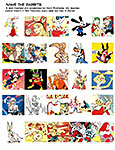

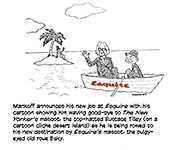
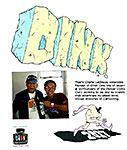





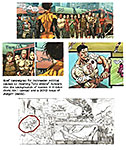

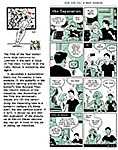
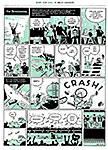
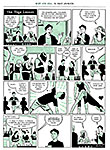






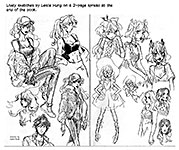
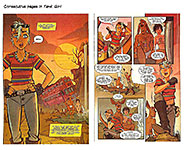
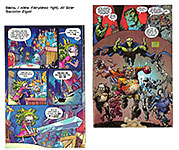
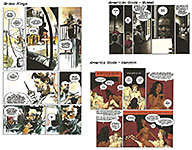
TrumpOReilly.jpg)
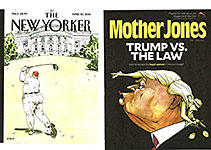

1.jpg)
2.jpg)
3.jpg)
4.jpg)
5.jpg)
6.jpg)
7.jpg)
8.jpg)
9.jpg)
1.jpg)
2.jpg)
3.jpg)
4.jpg)
5.jpg)
6.jpg)
6A.jpg)
7.jpg)
8.jpg)
9.jpg)
10.jpg)
